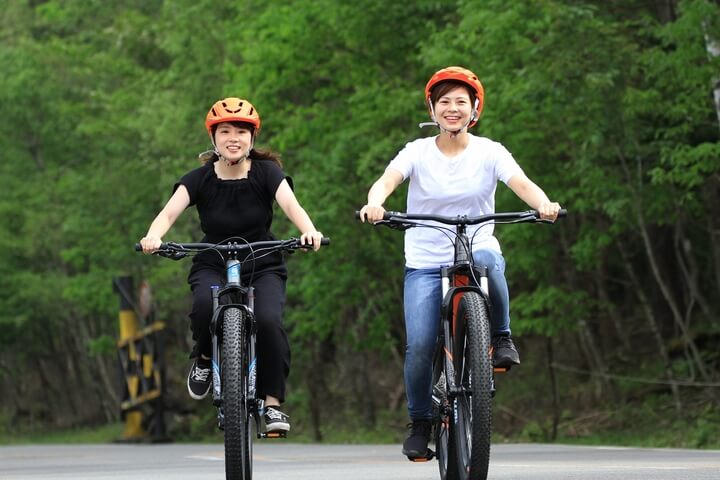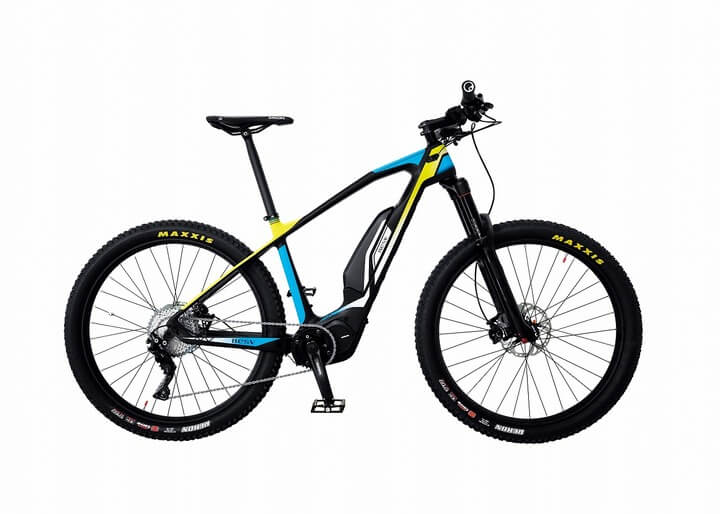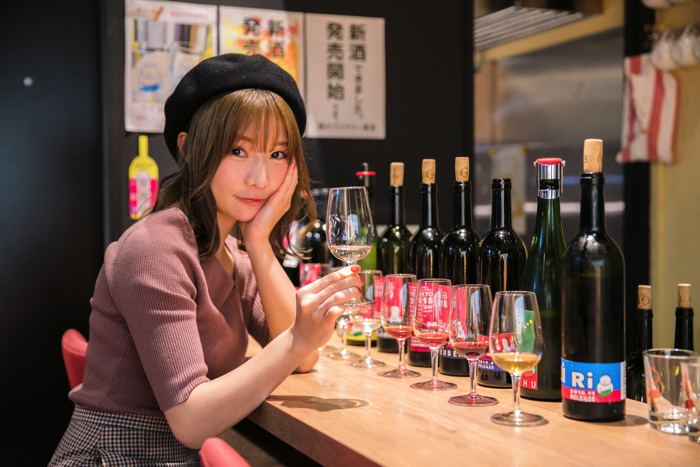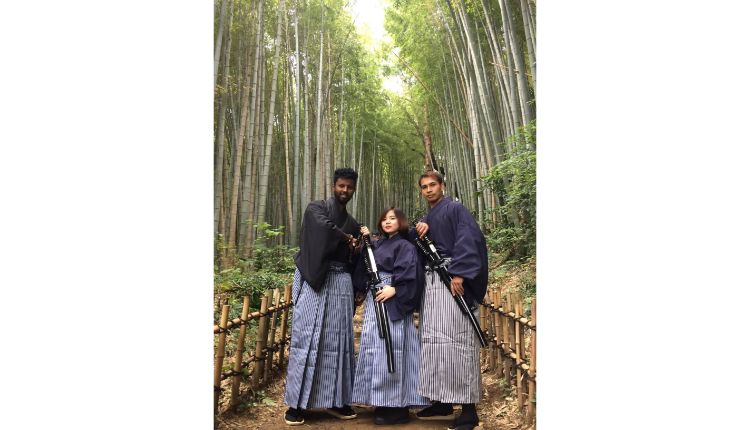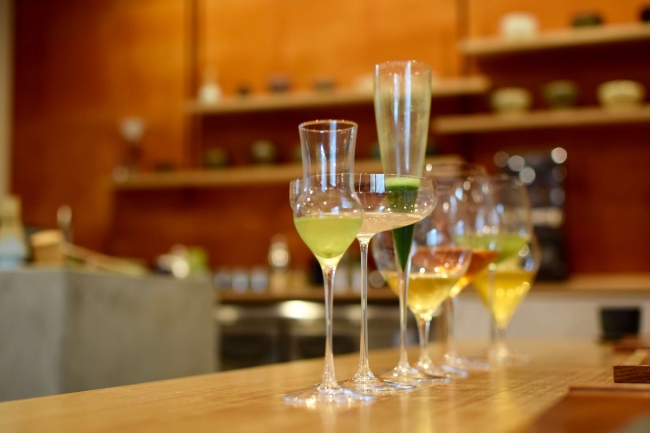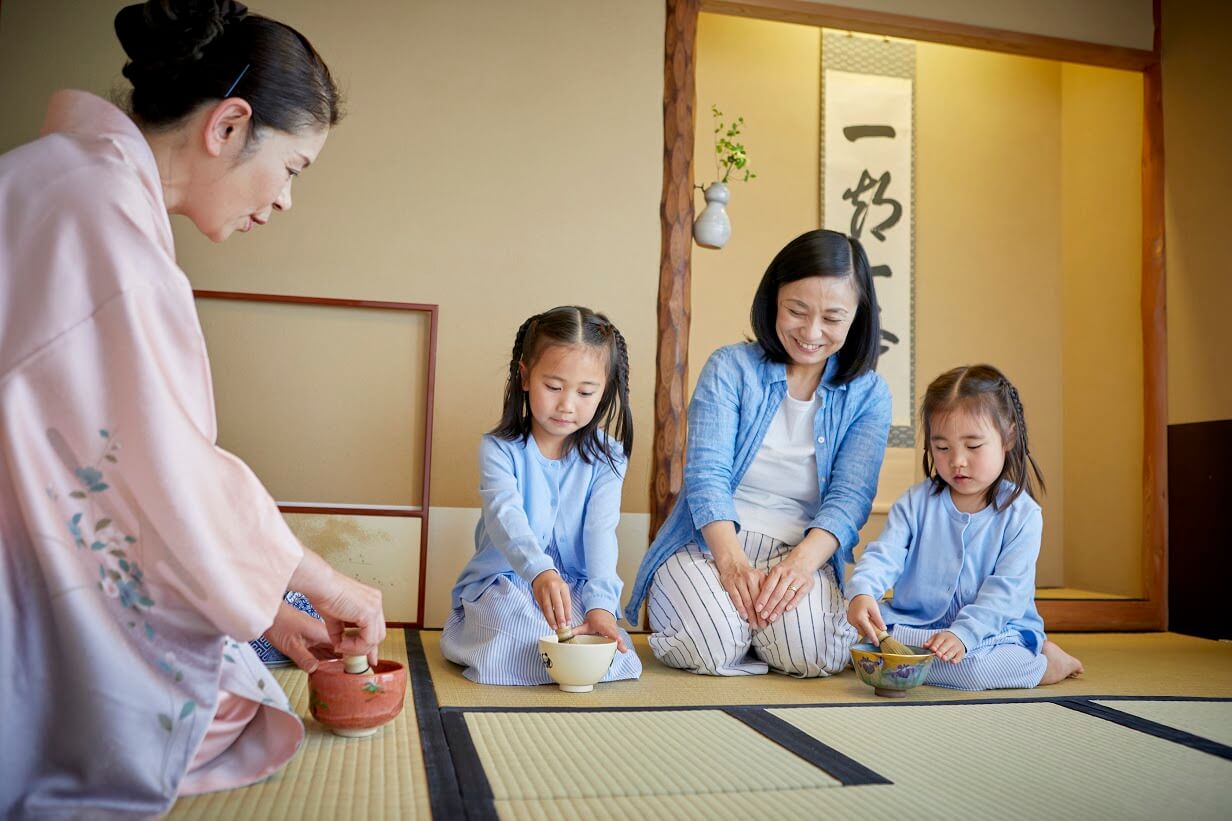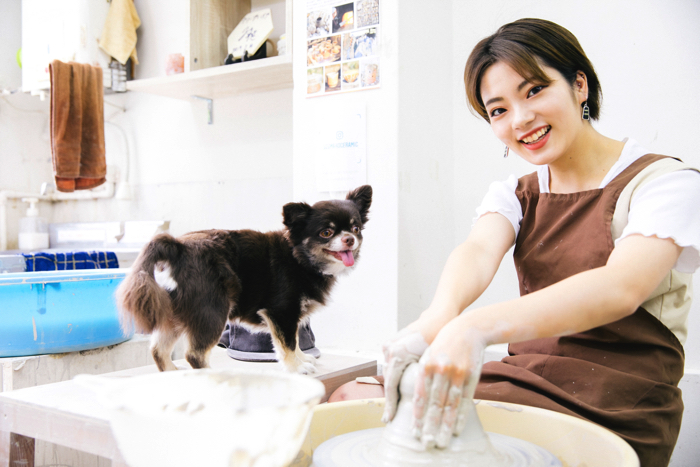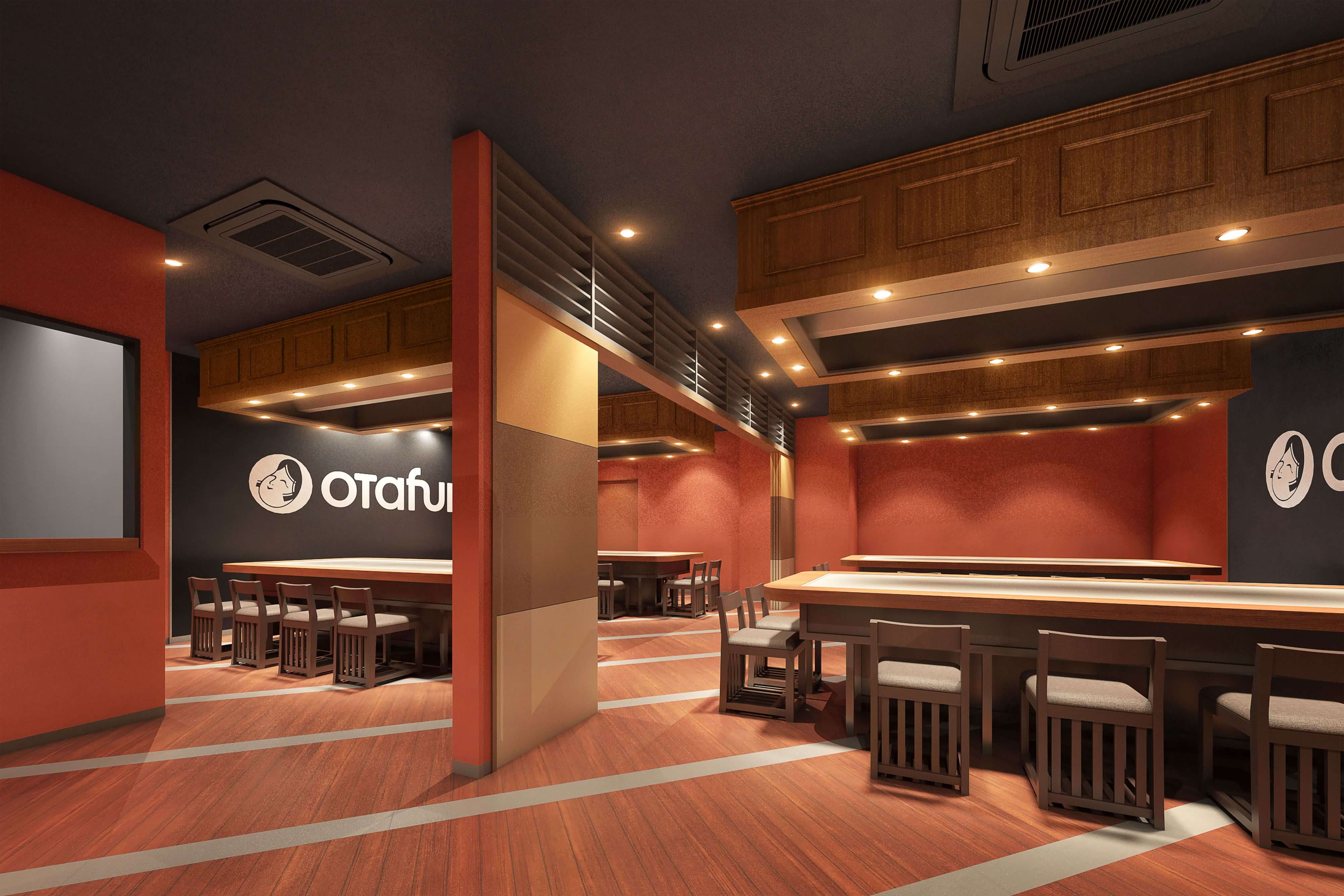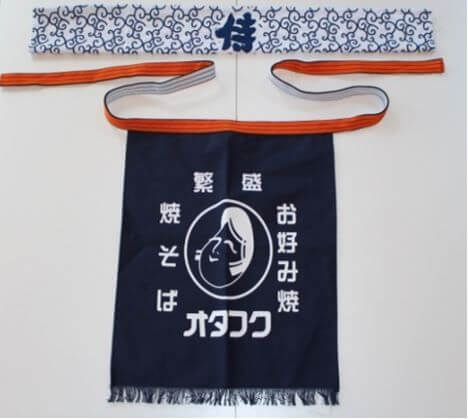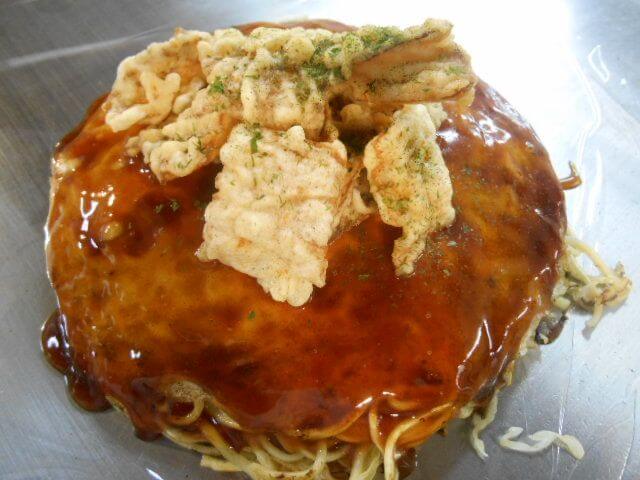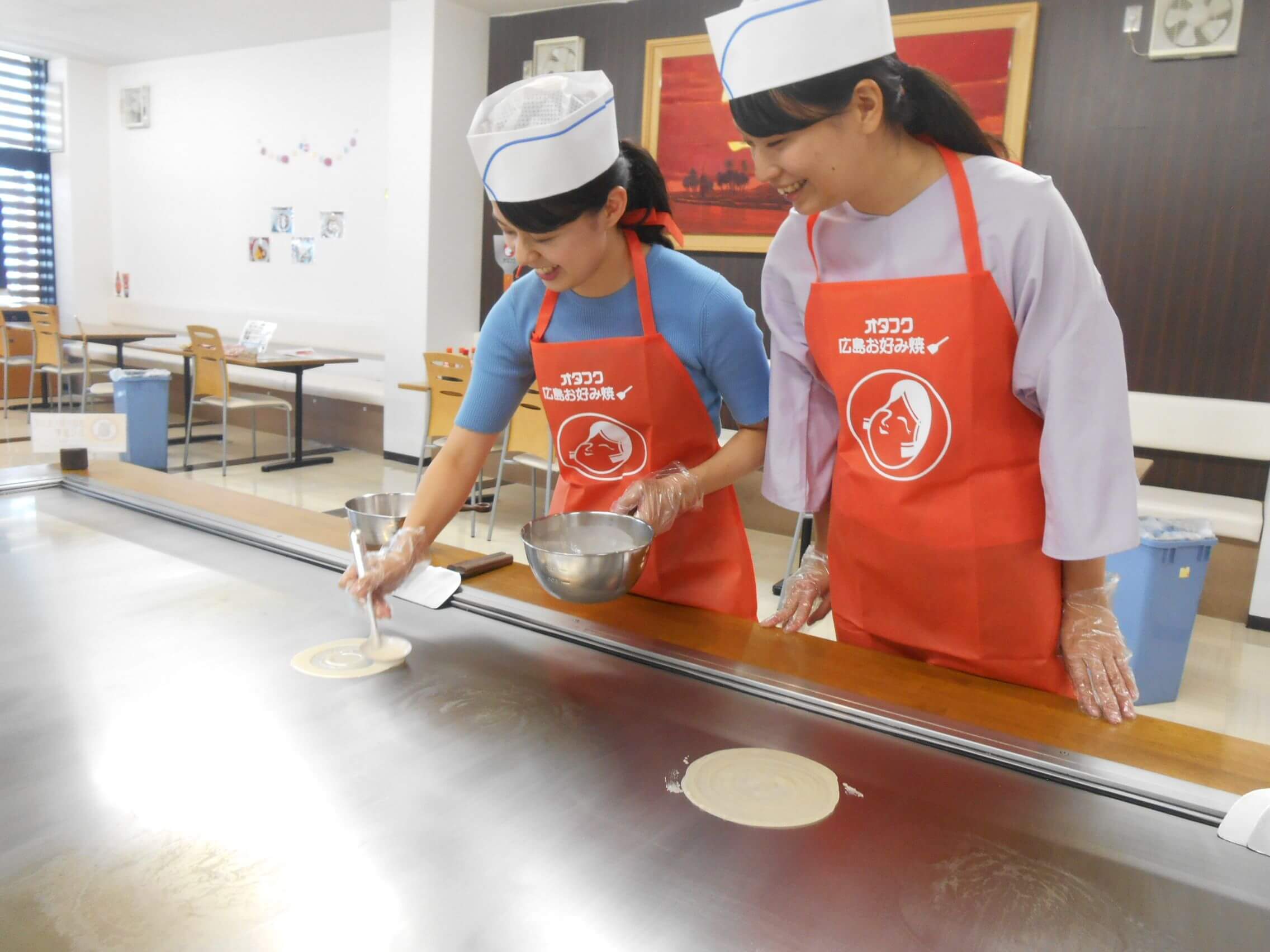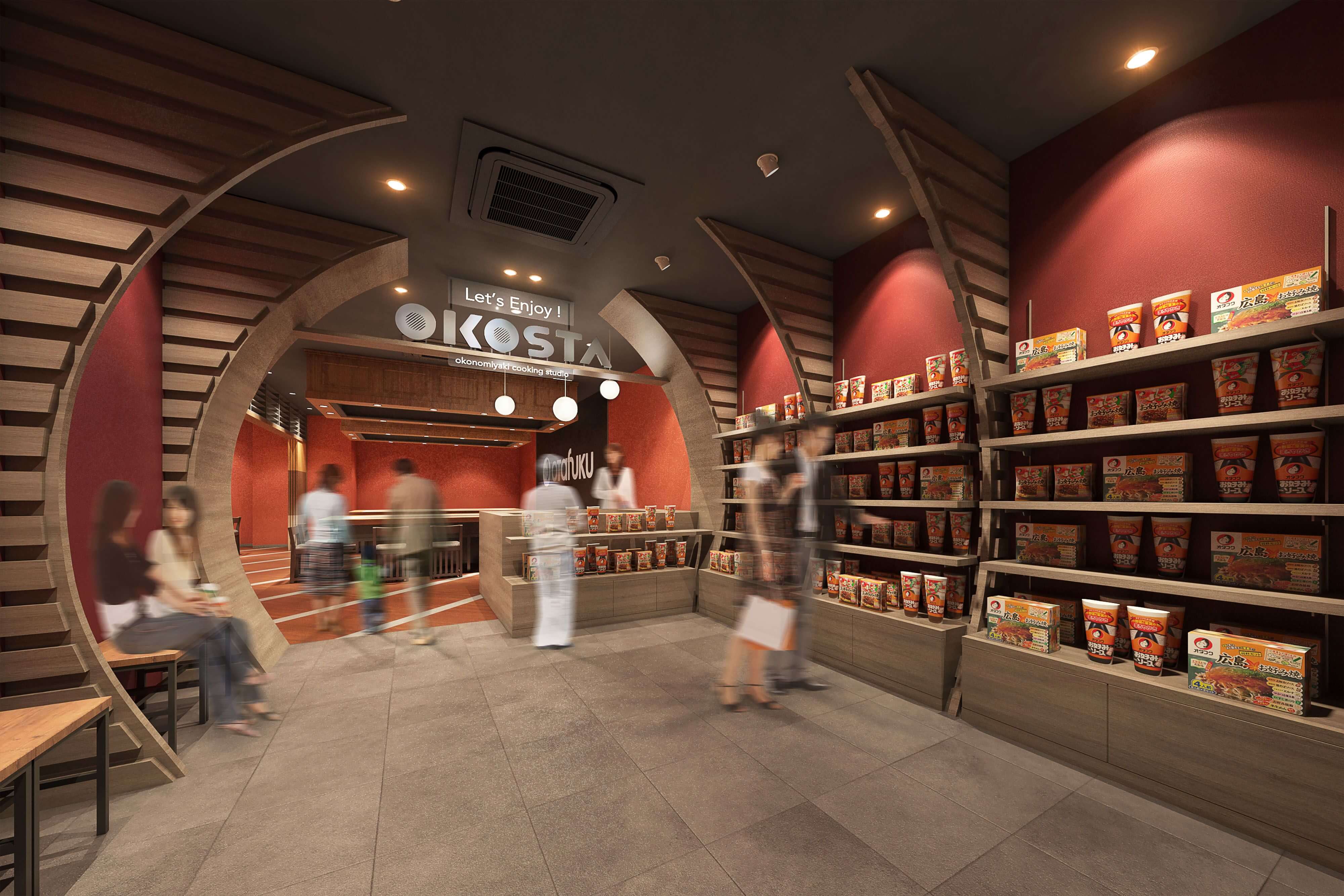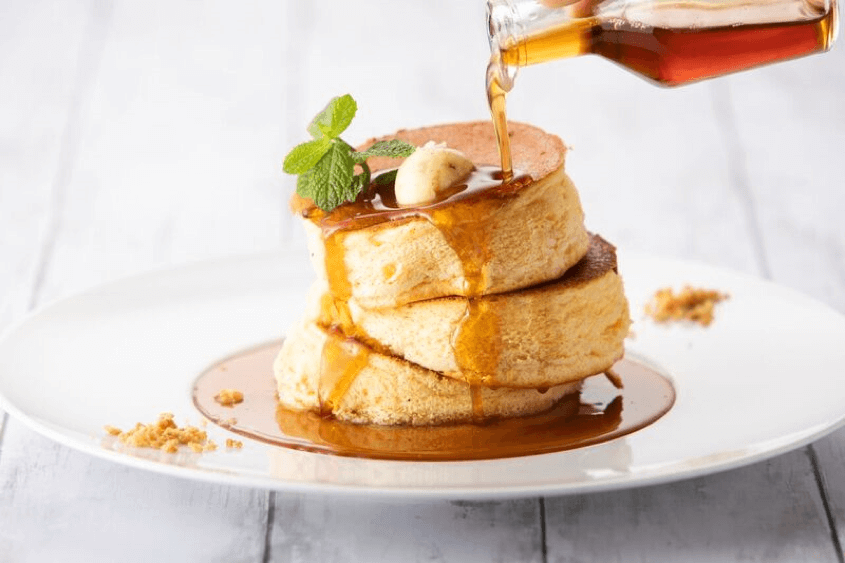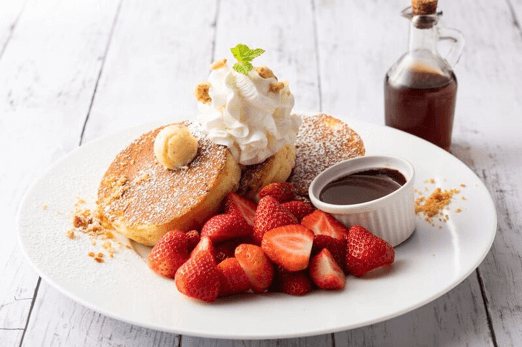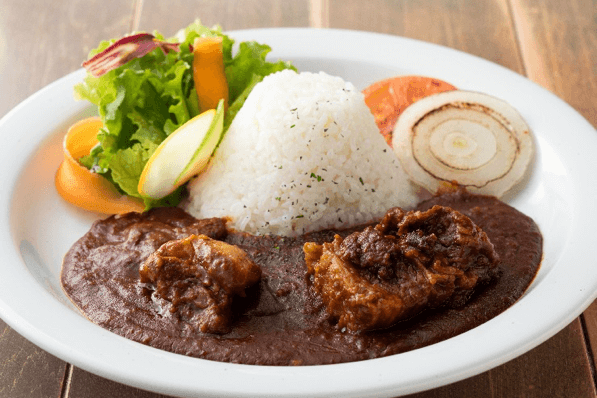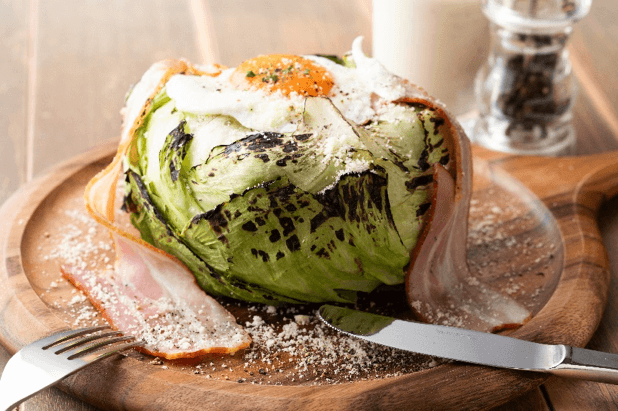The new bicycle activity shop BonVelo will open on June 1, offering a range of exciting activities including ‘Mount Fuji Downhill‘ and ‘Mount Fuji Hill Climb.’
Mount Fuji Downhill has mountain bikes delivered all the way up to Mount Fuji’s 5th station so you can ride down without stopping. This new activity is aimed at people who’ve made the effort to go to Mount Fuji and want to have some fun. Daisuke Imanaka, the first Japanese person to compete in Tour de France, was appointed as the project adviser of this activity, which is sparking much attention.
The shop’s name bon velo is French and means ‘good bicycle.’ Each activity they have on offer makes use of high grade mountain bikes and electronic sports bikes that can ride for you.
For example, if you take on the Mount Fuji Downhill Subaru Line course, a mountain bike will be delivered to the 5th Station at the entrance of the Yoshida Trail on Mount Fuji. From there, you will cycle down to the bottom, offering a truly special experience that you can’t easily get anywhere else.
In some other courses, like the Hill Climb course, you’ll get to use an e-bike. Since they are equipped with a motor, you won’t have to exert yourself, meaning even bike beginners or novices can enjoy themselves. You can even enjoy your ride as a couple or with friends.
Another great aspect is that there are plenty of activities for people of all levels, as well as people of all ages.
Experience the thrill of cycling down Mount Fuji yourself!
■Information
BonVelo
Plans & Prices:
・Mount Fuji Downhill Subaru Line Course
High Grade Mountain Bike w/ Semi Fat Tires
Time Required: 2-3 Hours
Distance: Approximately 30km
Price: ¥12,000 per person
This downhill course plan will deliver the bike and user to Mount Fuji’s 5th Station at the Yoshida entrance.
・Mount Fuji Downhill Umagaeshi Course
High Grade Mountain Bike w/ Semi Fat Tires
Time Required: 2-3 Hours
Distance: Approximately 17km
Price: ¥9,800 per person
This downhill course plan will deliver the bike and user to Yoshida Umagaeshi on Mount Fuji.
・Mount Fuji Hill Climb Course
Electronic Sports Bike w/ Semi Fat Tires OR High Grade Mountain Bike
Time Required: 4-5 Hours
Distance: Approximately 60km
Price: ¥10,000 per person (e-bikes are an additional ¥5,000)
This plan is a round trip course from the shop to the Subaru Line on Mount Fuji.
・Lake Kawaguchi Pottering Course
Electronic Sports Bike w/ Semi Fat Tires OR High Grade Mountain Bike
Time Required: 2-3 Hours
Distance: Approximately 24km
Price: ¥3,000 per person (e-bikes are an additional ¥5,000)
This course plan is a cruise cycle from the shop around Lake Kawaguchi at Mount Fuji.
Website: http://bonvelo.jp
RELATED ENTRIES
-
Sai Sai Jaran Jaran #8: SILENT SIREN’s Ainyan Becomes a Wine Connoisseur at Fukagawa Winery Tokyo in Monzennakacho
Sai Sai Jaran Jaran is a featured series here on MOSHI MOSHI NIPPON from the members of the all-female band SILEN SIREN (aka Sai Sai) who visit various hot spots in Japan and experience different things, the Sai Sai way.
Band bassist Ainyan enjoys a beer or cocktail, but she wants to step into the world of wine, so we will join her on her journey today as she goes to learn all about wine from the very basics.
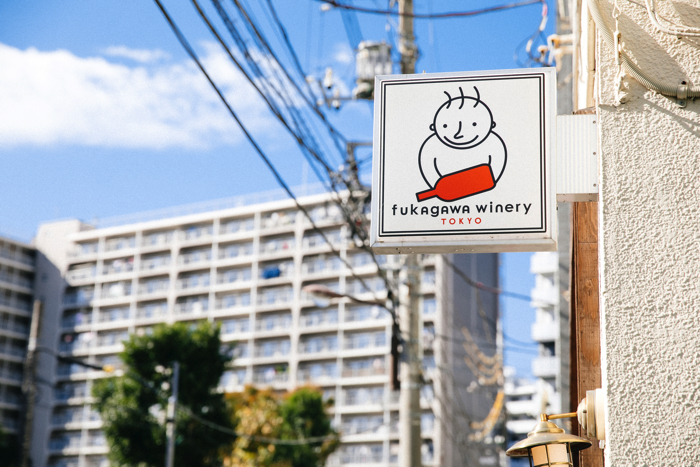
It’s a clear sky today. Great weather for going for a drink during the day, am I right?
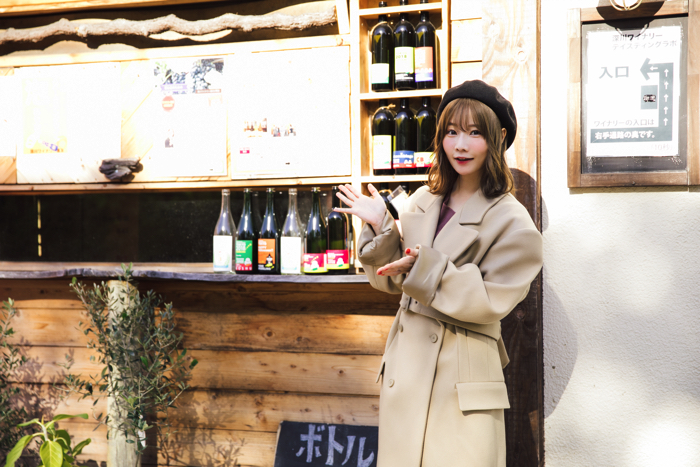
We visited Fukagawa Winery Tokyo in Monzennakacho, an area located in Shitamachi, Tokyo. We were looking forward to going there because it offers the full wine experience, allowing visitors to see wine brewing up close to learn all about it.
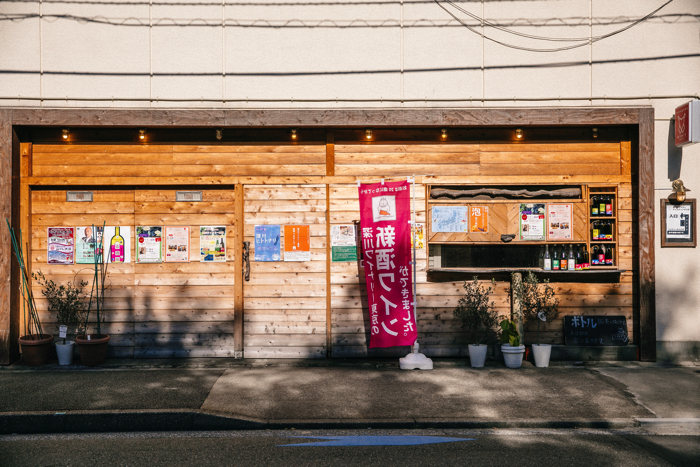
This experience is offered twice a day on weekends and national holidays at 14:00 and 16:00.
Fukagawa Winery Tokyo opened in Tokyo in 2016 as a winery where the ordinary person could go and see wine being made to fully understand its process. It has expanded its circulation in recent years and is now able to take in grapes from across Japan, including Tokyo, to craft many different wines.
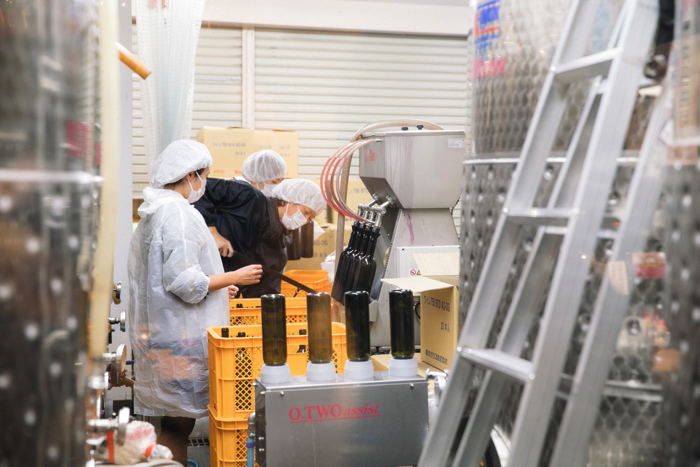
On the day we visited we saw the staff bottling up the wine. On average, the winery ships out around 30,000 bottles a year.
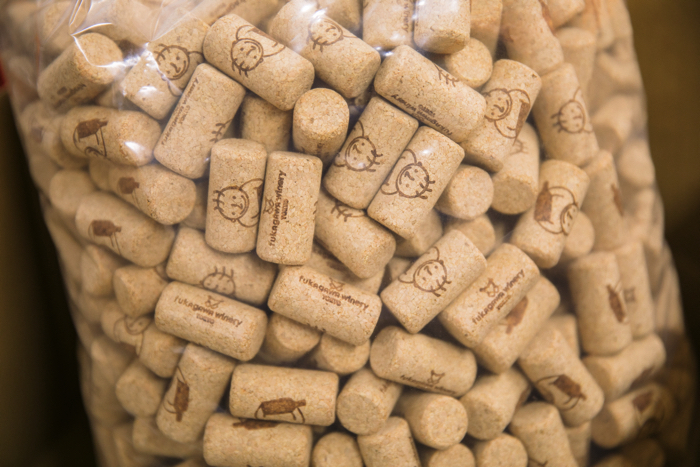
The corks have illustrations of “Wine Man” on them, a character created by Fukagawa Winery Tokyo. Ainyan was fairly fond of him!
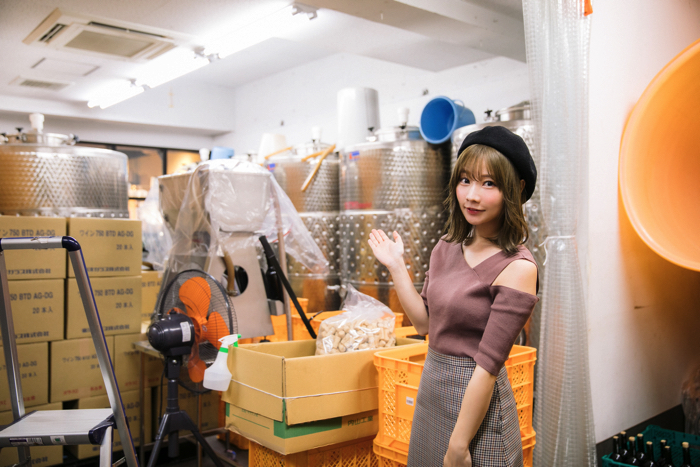
Time to see how the winery works!
When you step inside, the scent of grapes is the first thing to hit your senses.
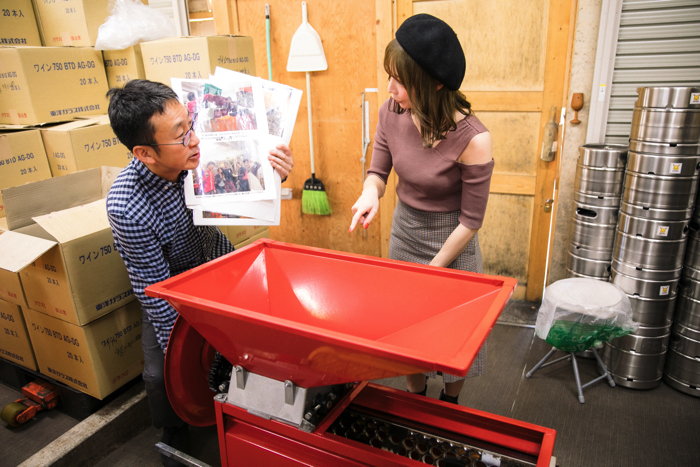
The one in charge of Fukagawa Winery Tokyo is Kousuke Ueno, who was kind of enough to show us around. He taught us the process of wine making, as well as what types of grapes and tools they use.
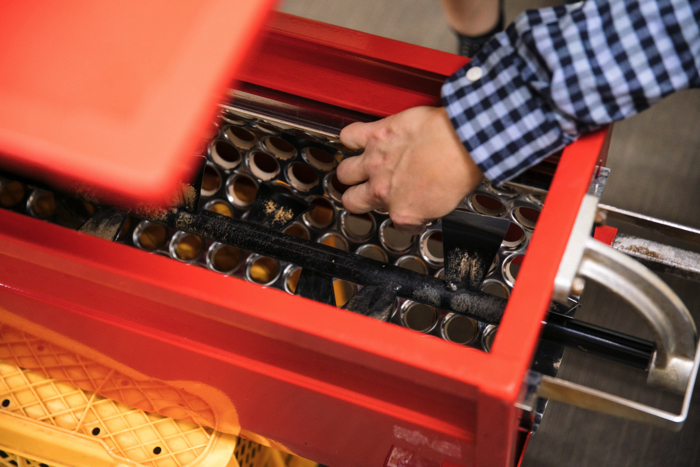
“This machine separates the grapes and stalks using the propellers. This method has been used for 150 years,” explained Ueno.
There are periods when visitors can observe this machine being used to separate the grapes. It takes place between mid-August to November, so follow Fukagawa Winery Tokyo’s social media for announcements and details.
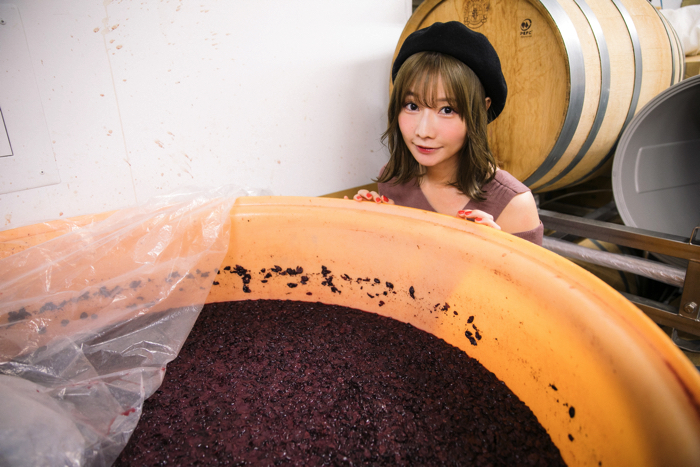
“Wow! It smells so good!” said Ainyan. We got to see a bucket where Cabernet Sauvignon was being made. They put in whole grapes with the skin on and add natural yeast for the fermentation process. The sweet smell of the grapes fills the air and makes you want to have a glass.
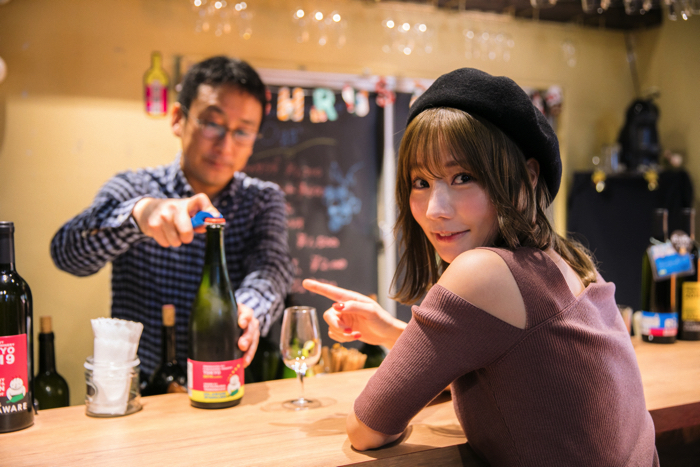
Now for what Ainyan has been waiting for: taste-testing time! She learned everything about the wine making process, so it was time to taste and compare some different wines.
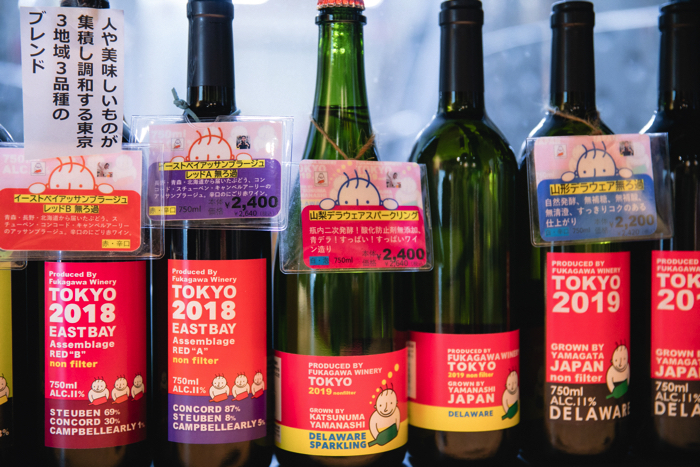
The winery allows taste-testing until 17:00. You can try 3 types for ¥700. And of course, if there’s one you tried that you really liked, you can buy it there and then. So sip, scrutinise, and select!
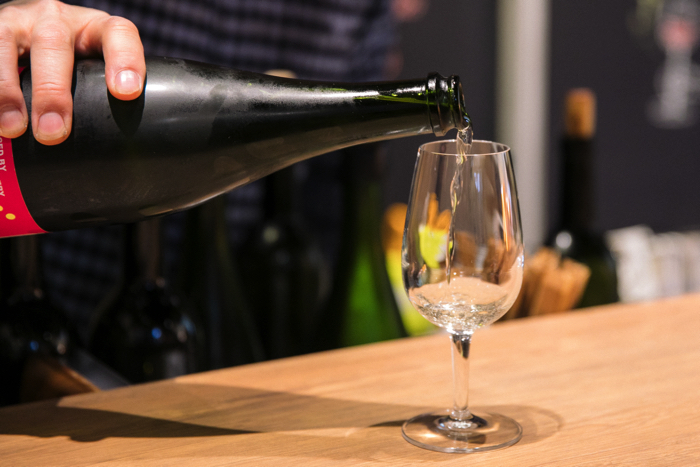
“Please try this one first. It is wine, but it’s like a lemon sour,” explained Ueno, recommending that Ainyan first try the Yamanashi Delaware Sparkling.
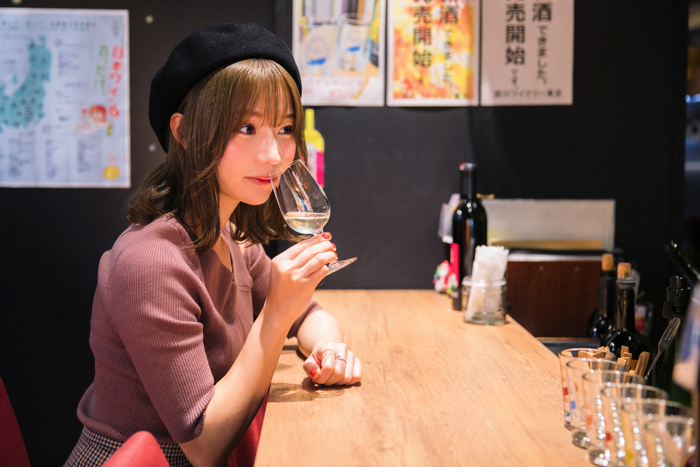
Soak up all the notes of the drink by having a good smell first before taking a small sip. “Smells really good. This sourness really is like a lemon sour! I wonder why?” said Ainyan.
This wine uses premature grapes which gives the wine a sour taste. The sourness of this wine can play the part of lemons, so it’s best paired with fried foods or meals with chicken in them.
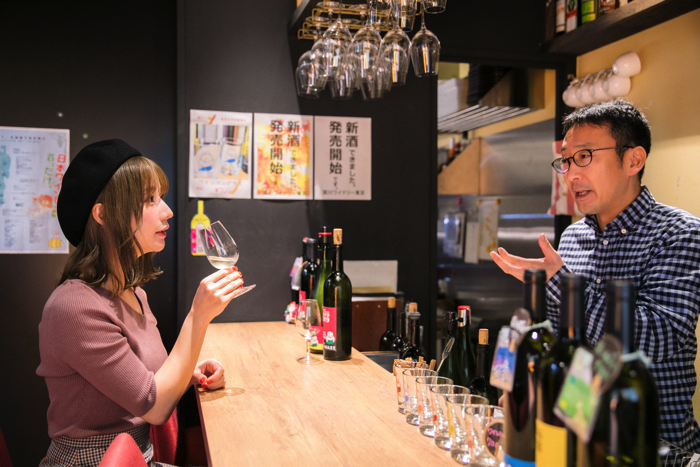
The second drink was the Yamagata Delaware Muroka. It’s an unfiltered wine made from completely ripened Yamagata Delaware grapes.
Unfiltered means that the filtration process to take out visible solids and such is not used. This gives it a slightly cloudy appearance and an exquisite taste that’s somewhere between wine and juice.
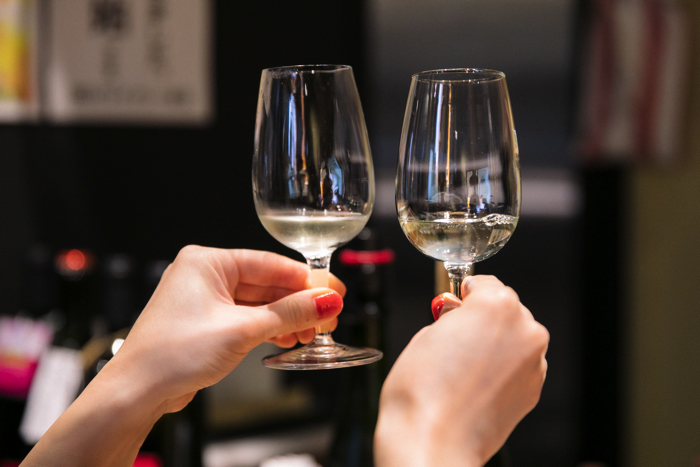
Left: Unfiltered Yamagata Delaware / Right: Filtered Yamagata Delaware
For the third glass, Ainyan ordered the filtered Yamagata Delaware to test the difference between it and the unfiltered version.
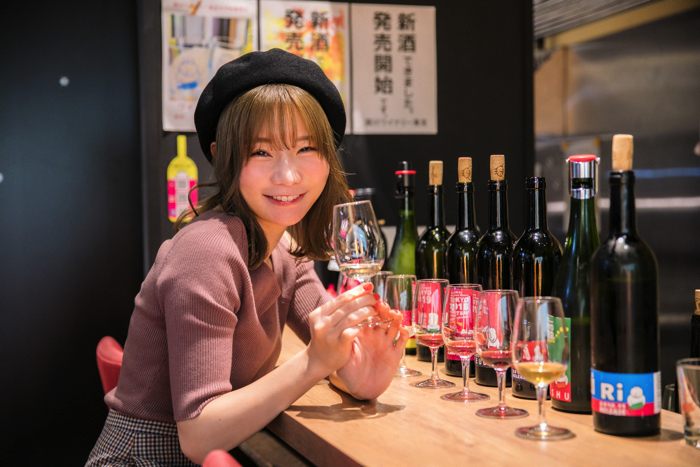
“The filtered one has a good balance of flavours and is refreshing. The unfiltered one has a smooth juiciness to it. They’re both delicious, but I like the unfiltered one more!” said Ainyan.
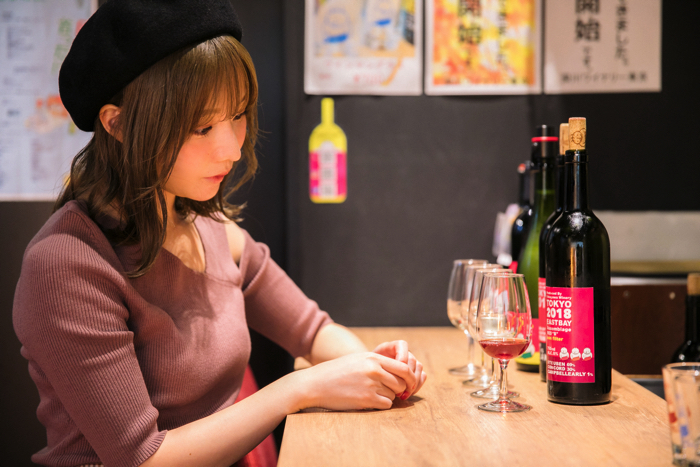
Her fourth glass was an unfiltered red wine: the East Bay Assemblage Red B.
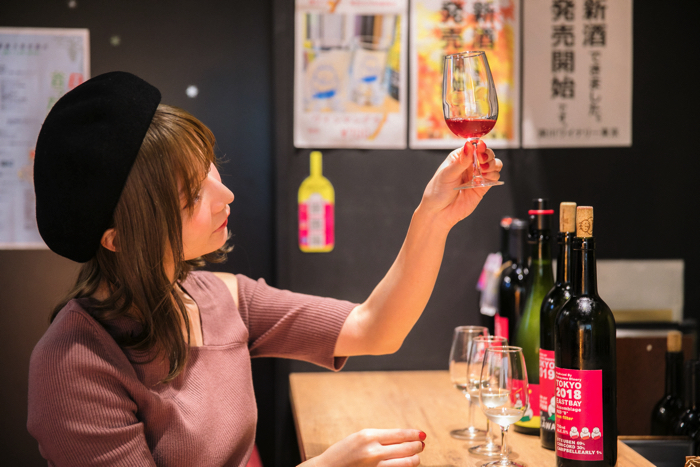
The grapes used are a combination from Hokkaido, Nagano, and Aomori. It really is an assemblage!
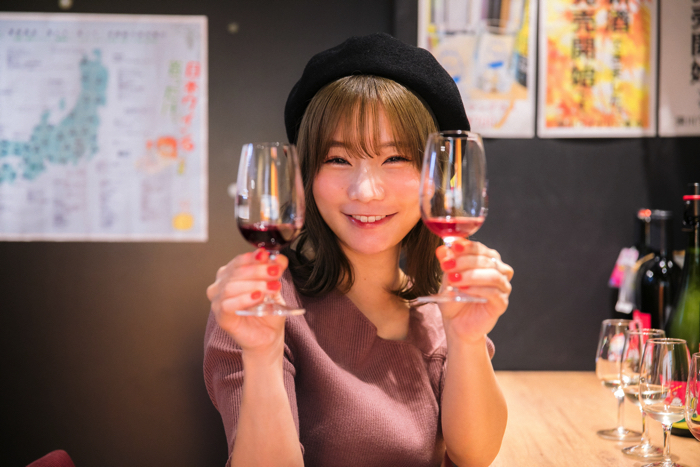
“The red wine has such a different taste and colour depending on the type too! This dark red wine is close to what I usually drink!” said Ainyan with a happy smile.
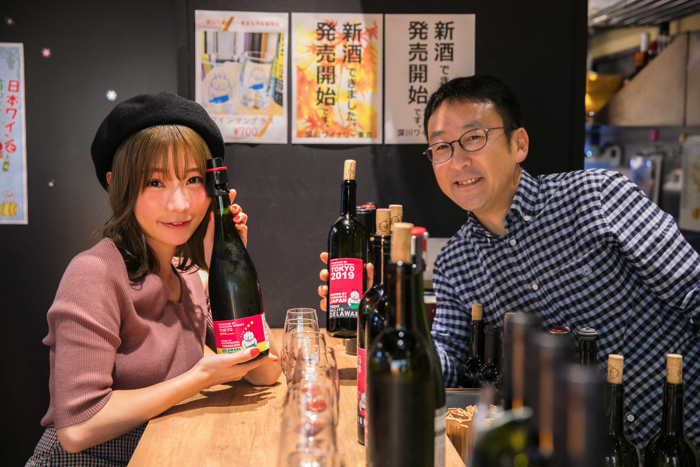
At the end of the session, Ainyan had tried 10 wines and bought two bottles! She was delighted with her experience, saying: “I was surprised how different each and every one of the wines I tried at Fukagawa Winery Tokyo were. I think I’m getting hooked on the appeal of unfiltered, natural wines.”
With Christmas and New Year around the corner, now is the season to indulge in wine. If you’re in Tokyo this December, pay a visit to Fukagawa Winery Tokyo for a full wine experience.
Writer:Yuki Yokoo
Photographer:Kayo Sekiguchi
SILENT SIREN
SILENT SIREN is a four-member all-female band consisting of vocalist & guitarist Sumire “Suu” Yoshida, drummer Hinako “Hinanchu” Umemura, bassist Aina “Ainyan” Yamauchi, keyboardist Yukako “Yukarun” Kurosaka.
The band made their major debut in November 2012 with their single Sweet Pop! The band is known to fans by their nickname “Sai Sai.” They are especially popular with middle school girls in Harajuku and have over 540,000 follows on their official LINE account.
In 2015, they performed their first solo concert at Nippon Budokan, making them the fastest Japanese all-female band in history to perform there after their major debut. In 2016, they performed a headline show at Yokohama Arena, and embarked on a world tour consisting of 6 shows in 5 countries.
At the end of 2016, they changed label to Universal Music and revamped their band logo and how they write their band name. In 2017, they wrapped up their 5th anniversary tour with their first two-day concert series at Nippon Budokan.
In 2018, they embarked on their biggest Japan tour to date “Tenkaippin presents SILENT SIREN LIVE TOUR 2018 ~”Girls will be Bears” TOUR~ consisting of 33 shows. They also performed at big music festivals and at countless events, as well as performed their annual New Year’s solo concert at Yokohama Cultural Gymnasium.
In 2019, they began celebrations of 7 years since their debut and 10 years as a band. They released their final album of the Heisei era and 6th album in total 31313 on March 13 ,2019 and promoted it on their tour SILEN SIREN LIVE TOUR 2019 “31313” ~Sai Sai 10th Anniversary~ supported by Tenkaippin. They also performed at numerous summer festivals and events.
On December 30, 2019, they will performed their annual New Year’s concert “SILENT SIREN Nenmatsu Special Live 2019 HERO” at Yokohama Cultural Gymnasium.
In 2020, they will celebrate 10 years since forming the band with a show at Yamanakako Communication Plaza Kirara on September 20, 2020.
SILENT SIREN Official Website: https://silent-siren.com/
Information
Fukagawa Winery Tokyo
TEL: 03-5809-8058
Address: Takahata Bldg. 1F, 1-4-10 Furuishiba, Koto Ward, Tokyo
Opening Hours: Weekdays 15:00-22:00 / Weekends & Public Holidays 12:00-22:00
Closed: Tuesdays
Winery Observations: Weekends & Public Holidays at 14:00 and 16:00 for 20 minutes each. Must book in advance.
Official Website: https://www.fukagawine.tokyo/
-
WASHOKU: Asakusa’s Newest Restaurant For Experiencing Japanese-Style Cuisine
Asakusaーone of the hottest spots in Tokyo for sightseeing, ever-bustling with Japanese and foreign tourists and travellers alike. This ancient district is famous not only for its sights, like Sensō-ji (the oldest temple in Tokyo) and the Nakamise-dōri shopping street leading up to it, but for its bountiful offering of gourmet restaurants.
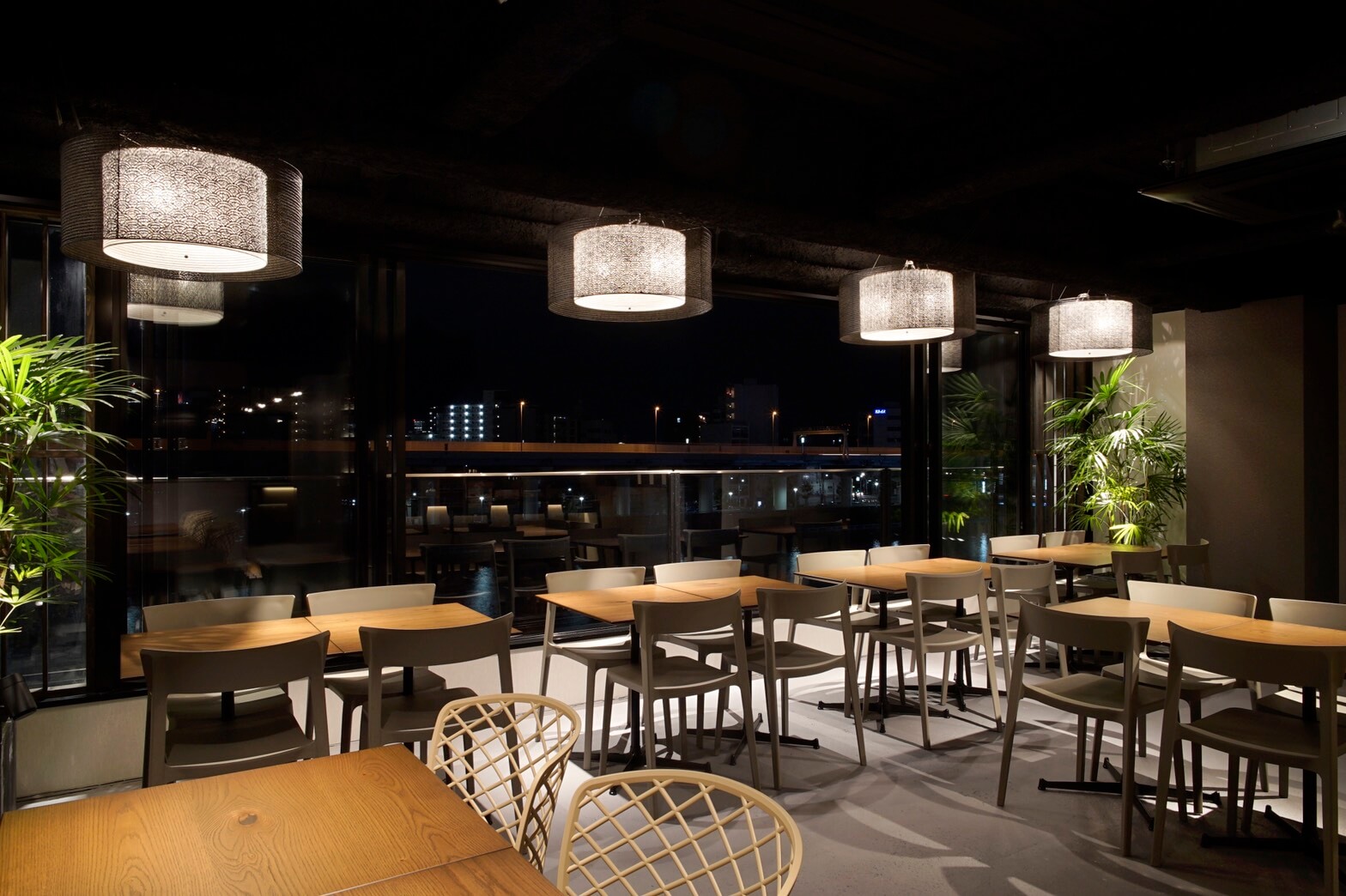
Today, we’re taking a look at Taikenkei Dining -WASHOKU-, a restaurant which opened in Asakusa on November 19 this year. If you’re looking for the full package when it comes to experiencing Japanese food culture, WASHOKU has customers covered. Not only do they serve food, like traditional Kyoto obanzai, but they offer cultural experience plans too where you can learn to make sushi or dress up in a kimono and walk the old streets of Asakusa.
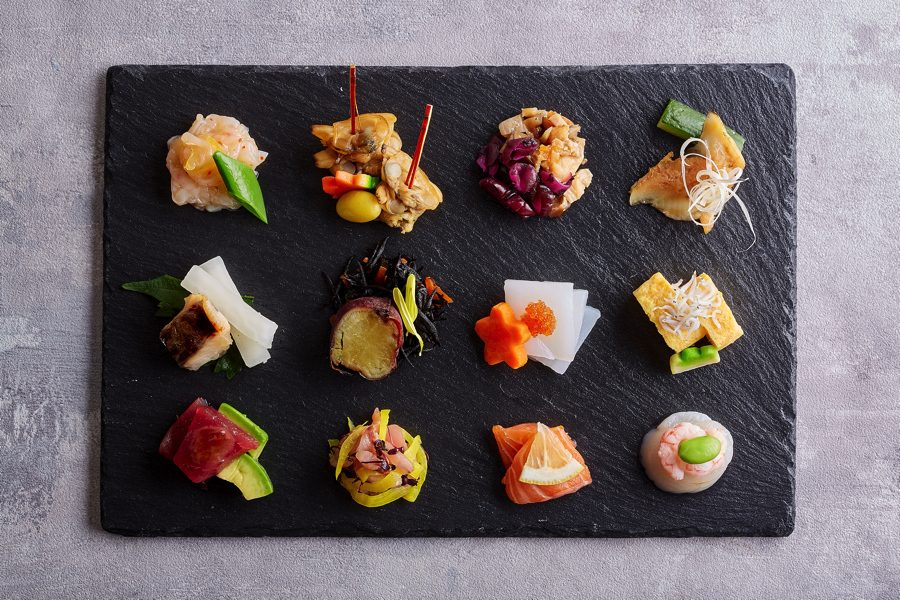
WASHOKU’s concept when it comes to both lunch and dinner centres around enjoying Japanese-style food that is colourful. And that rings tantalisingly true with their kaleidoscopic obanzai, which is formed of 12 vivid bite-sized delights. Obanzai is a traditional style of Japanese cuisine that comes from Kyoto, made up of mostly seafood and vegetables. The obanzai served at WASHOKU was conceived under the guidance of nutritionists, and so is packed full of healthy nutrients for the body. Not only that, the ingredients selected are all domestic to Japan, and are of a very high quality.
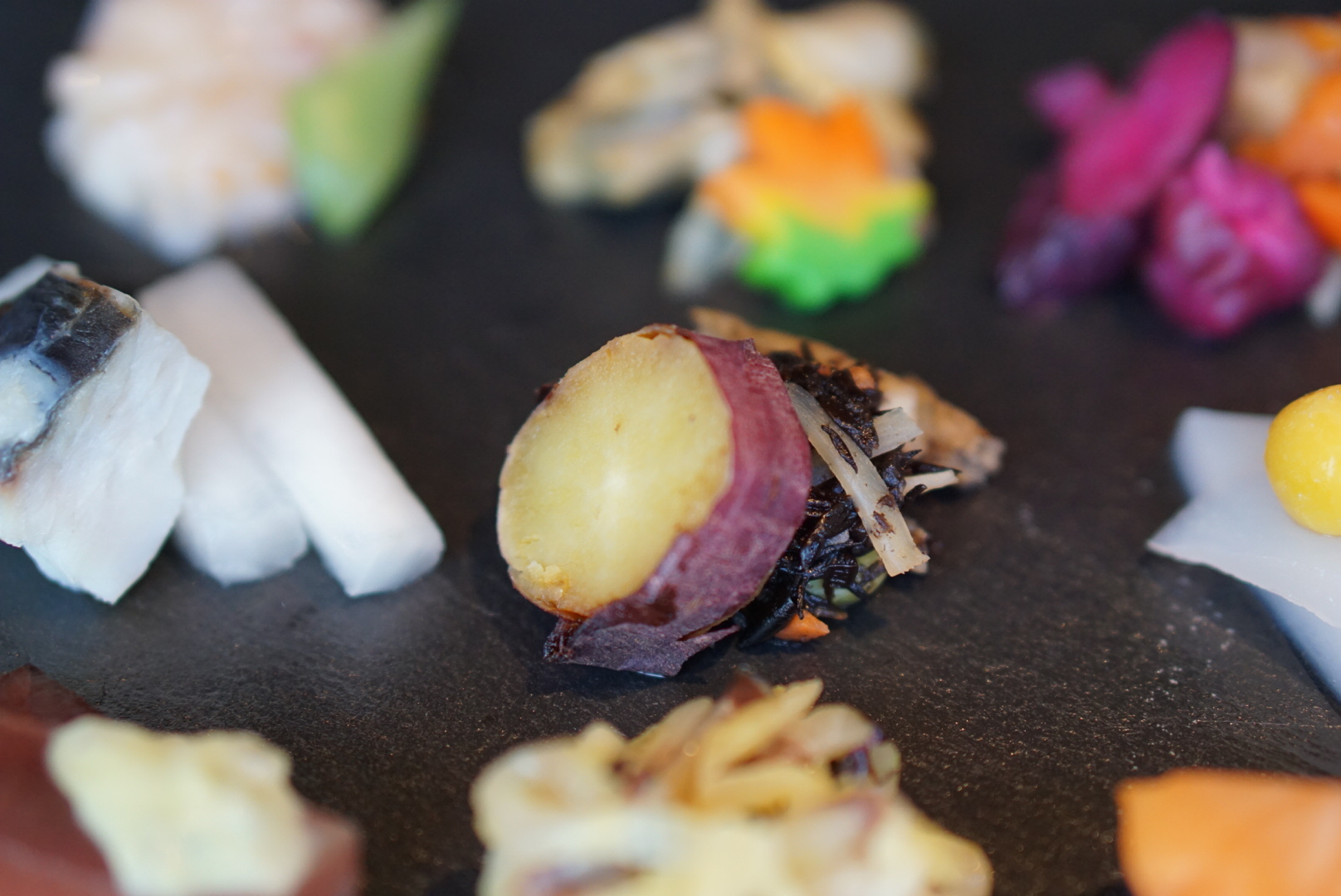
The obanzai I ate included fried beni haruka sweet potato which is sourced from Ishida Farmsーa sweet potato growerーin Katori, Chiba. It had a moist texture and rich sweetness. When I sank my teeth into it, I was flushed with feelings of the fall season.Other foods in the assortment included sashimi, scallop and yuzu, saikyo-yaki Kyoto-style grilled fish, and more. Each mouthful of the selection offered its own distinct and unique flavours.

The obanzai is served with miso soup too with which you get to choose a miso ball from a variety of flavours to put into your bowl. I went for the sesame seed miso ball.
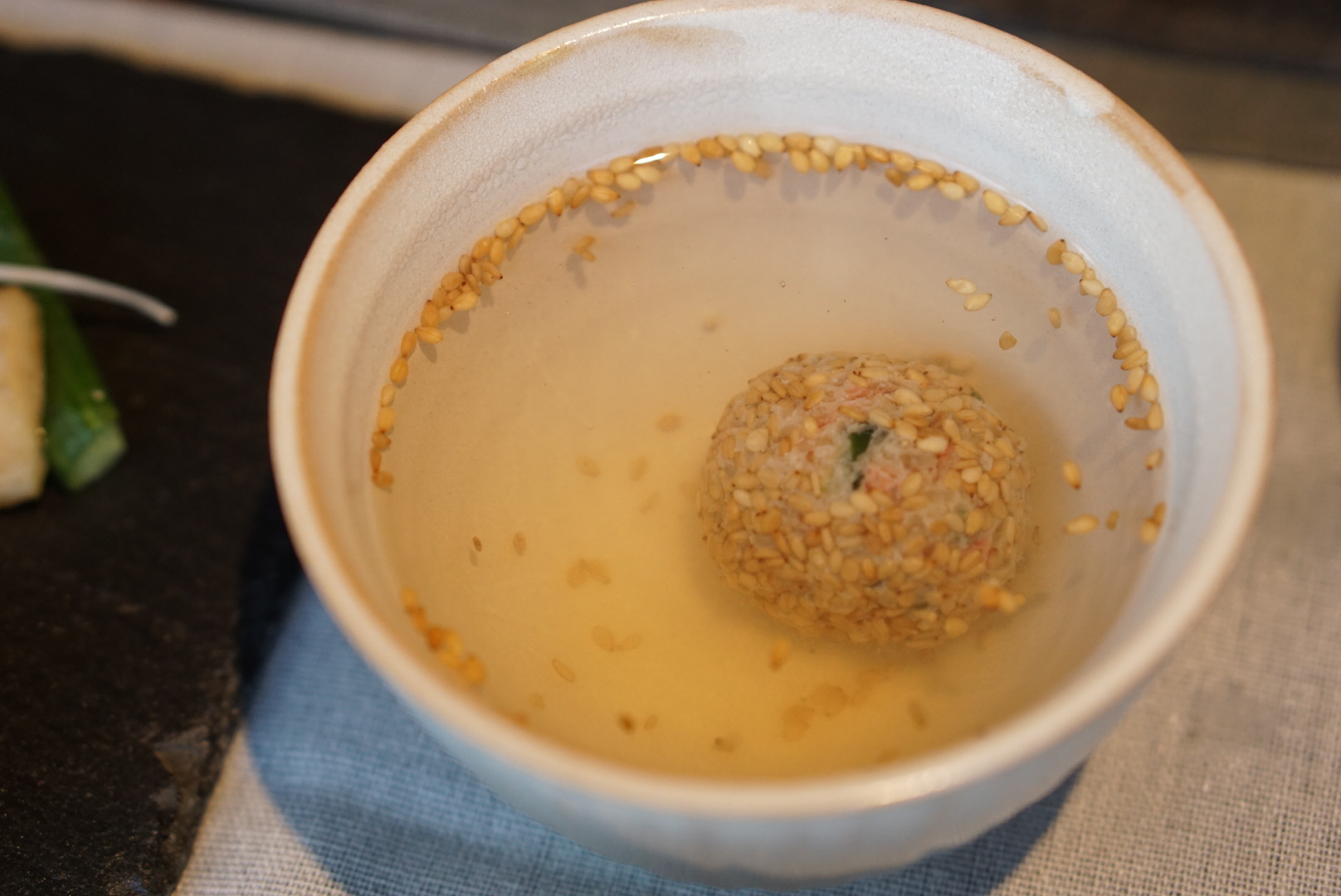
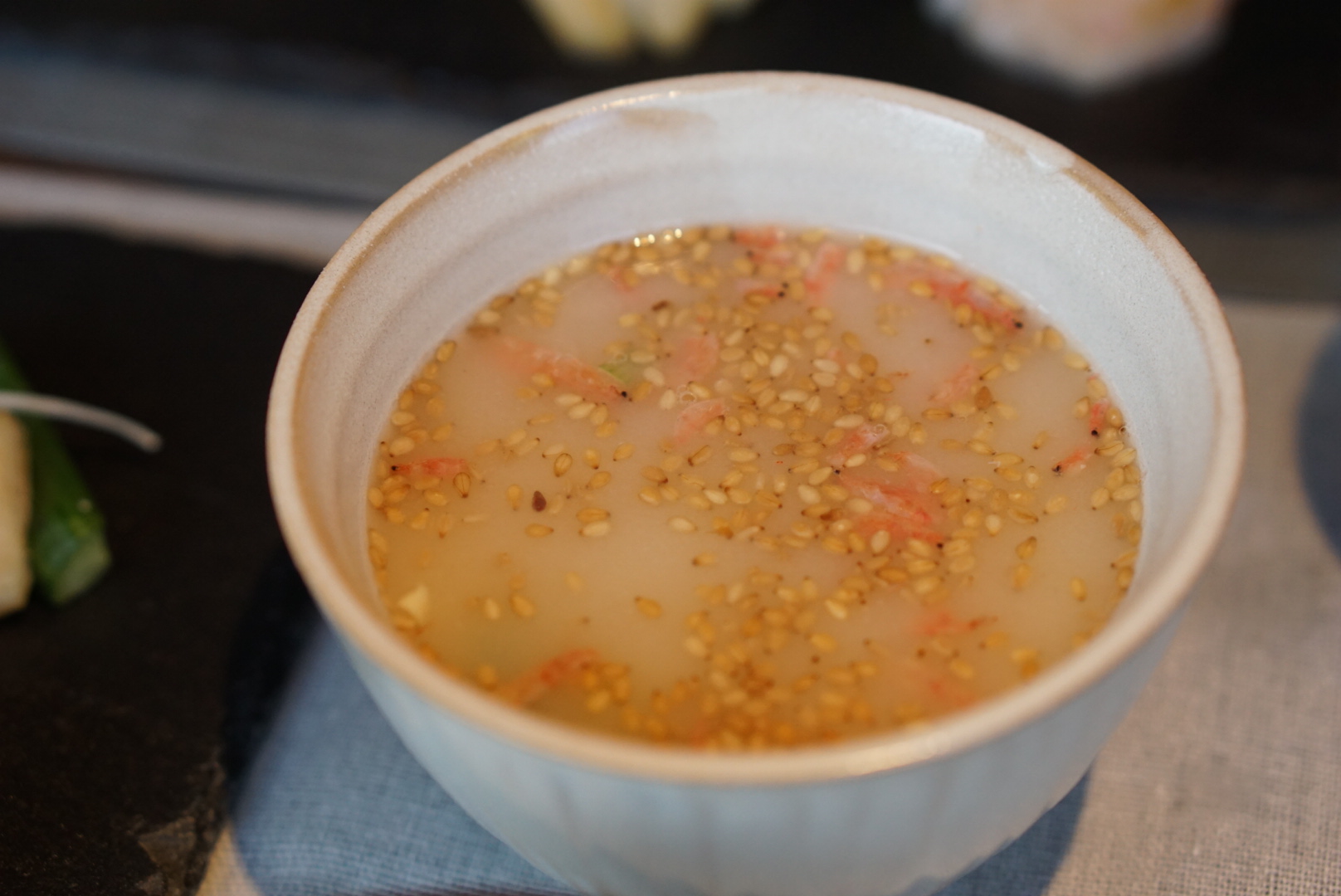
The miso ball is made from miso paste and various ingredients. Once placed into the hot water, it melts and turns into miso soup. The sweet light-brown miso was perfect for warming up my chilly self.
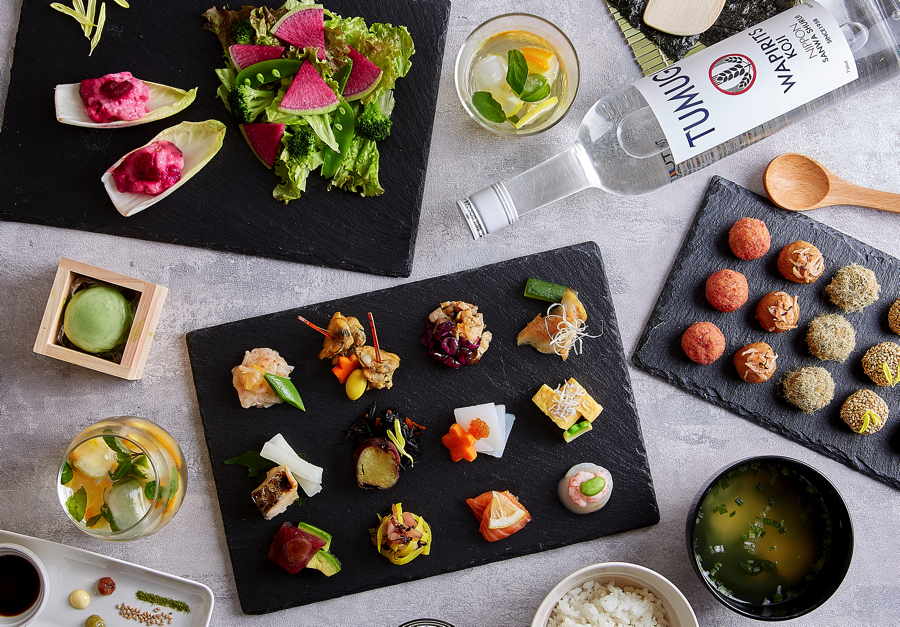
Dinner also features a dessert menu, as well as courses with an all-you-can-drink option, so I recommend these options for people who want to relax and take their time with their dining experience.
As I mentioned earlier, WASHOKU also offers a variety of experience-based plans. This includes a sushi class where you can learn to make your own hand-rolled sushi.
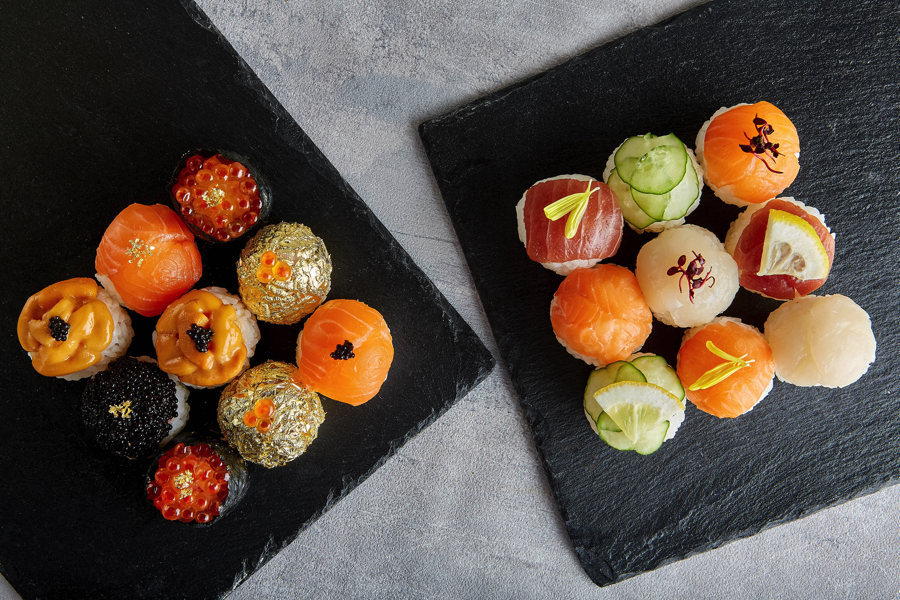
There are two types of “temari” hand rolled sushi you can make: the regular type, which makes use of tuna, salmon and other classic sushi toppings, and the high quality type, which uses more high-end ingredients like uni sea urchin eggs, caviar, gold leaf, and more. And for foreign customers, the restaurant has prepared a handout detailing the history of Asakusa and recipes, as well as souvenirs for them to take home.
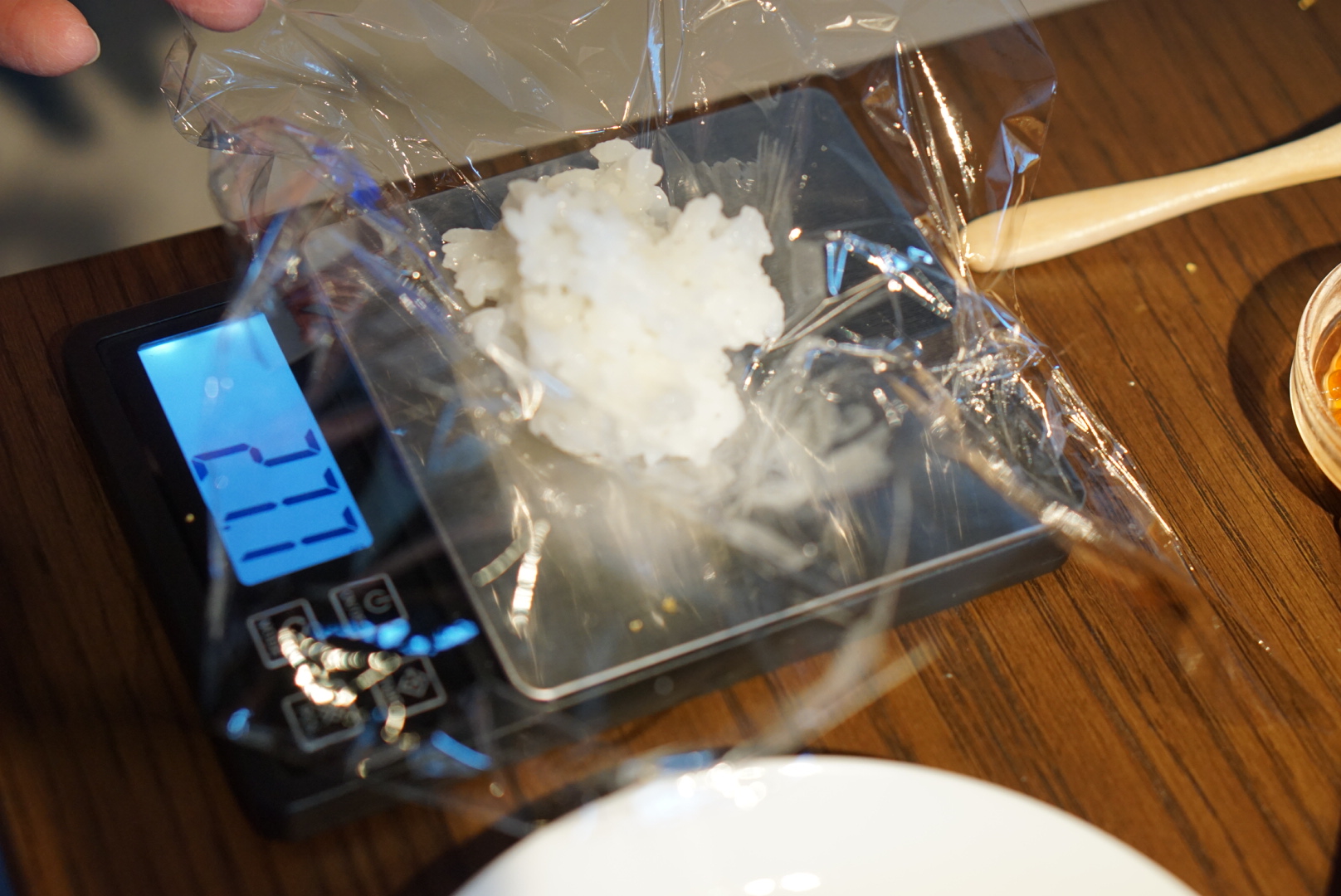
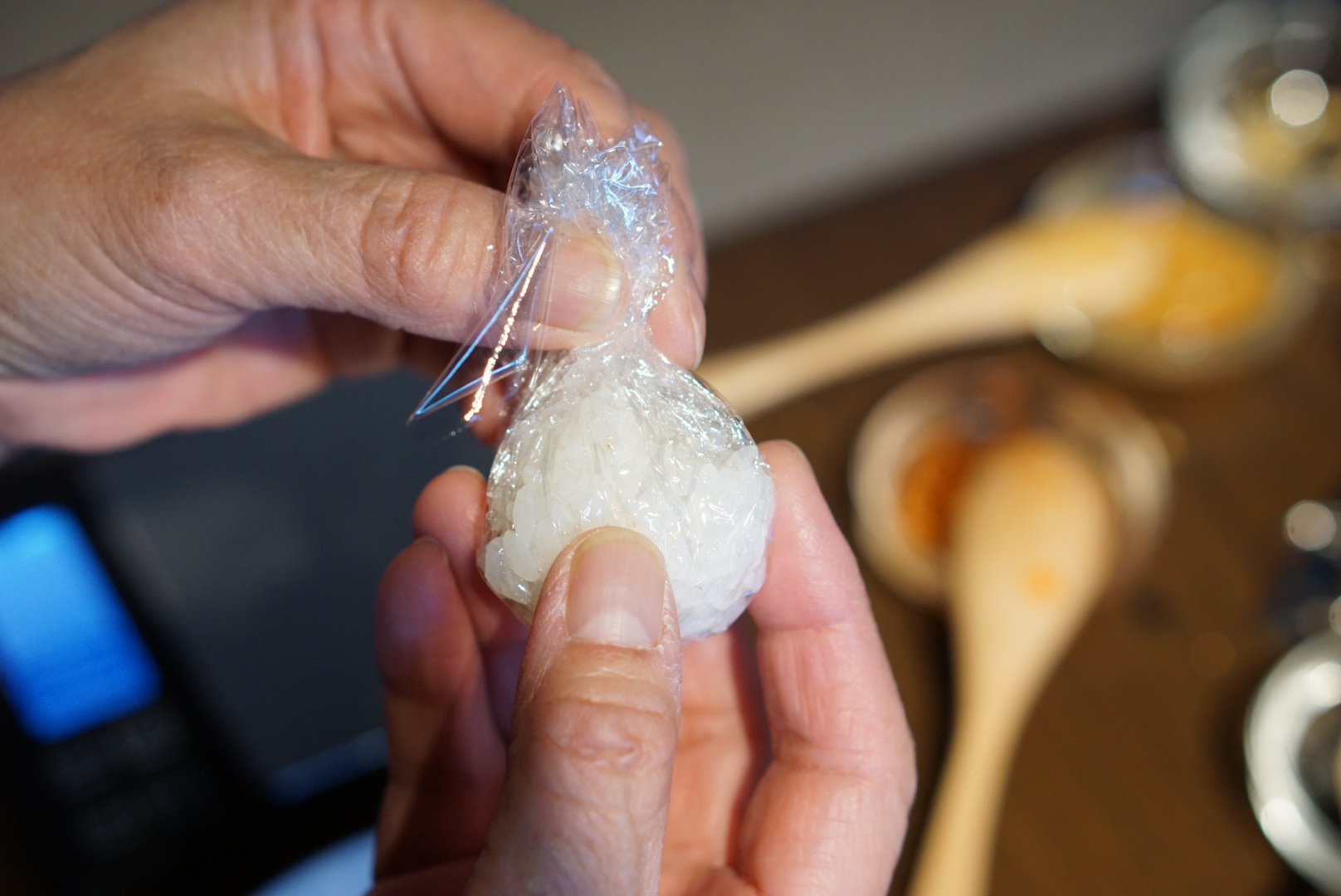
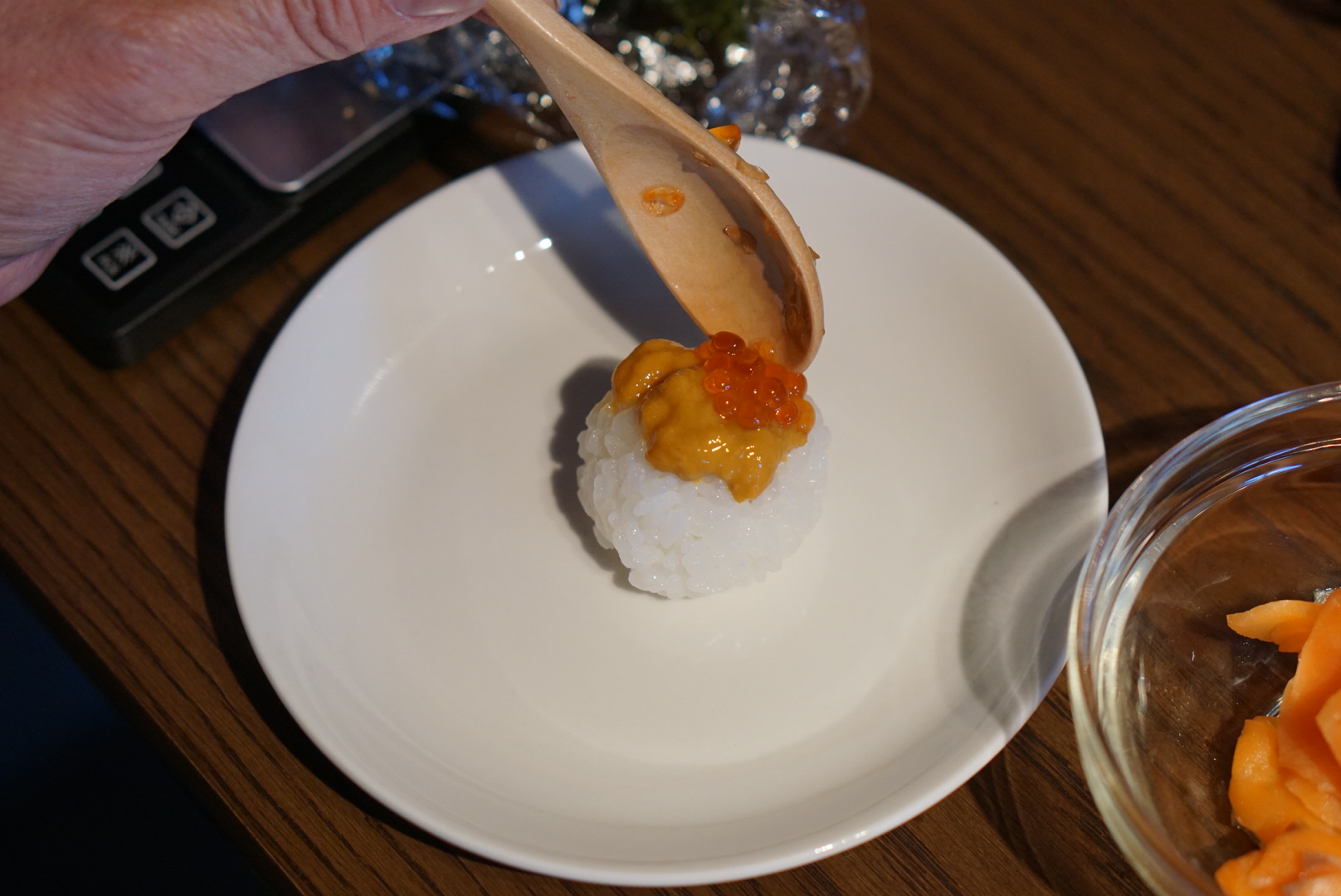
The MMN team of course had to have a go at making our own sushi, but it proved quite difficult. You have to get the right amount of sushi rice to roll, then actually roll it perfectly into a ball before topping with your ingredients. But the sushi I made was actually really delicious! To attend this class you have to book in advance, so if you’ve never tried making your own sushi before or have an need some guidance, then we can’t recommend it enough.
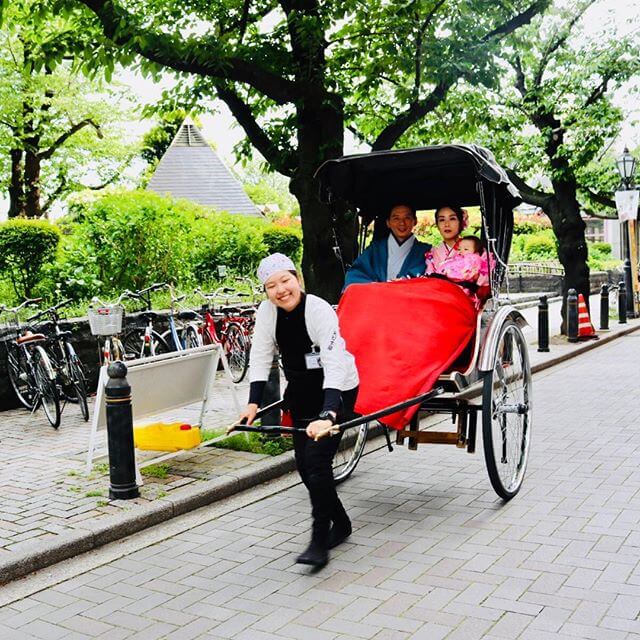
As well as food-related experiences, WASHOKU provides customers with three different plans to experience Japanese culture. The first of these is the rickshaw ride, where you board a rickshaw pulled by a runner and are taken around the various sites of Asakusa. The ‘Excursion Around Asakusa Course’ takes you to the most popular spots around Kaminarimon, while the ‘Sky Tree Course’ takes you all the way to the Sumida River, and you also get to see Tokyo Skytree and various other attractions in Asakusa.
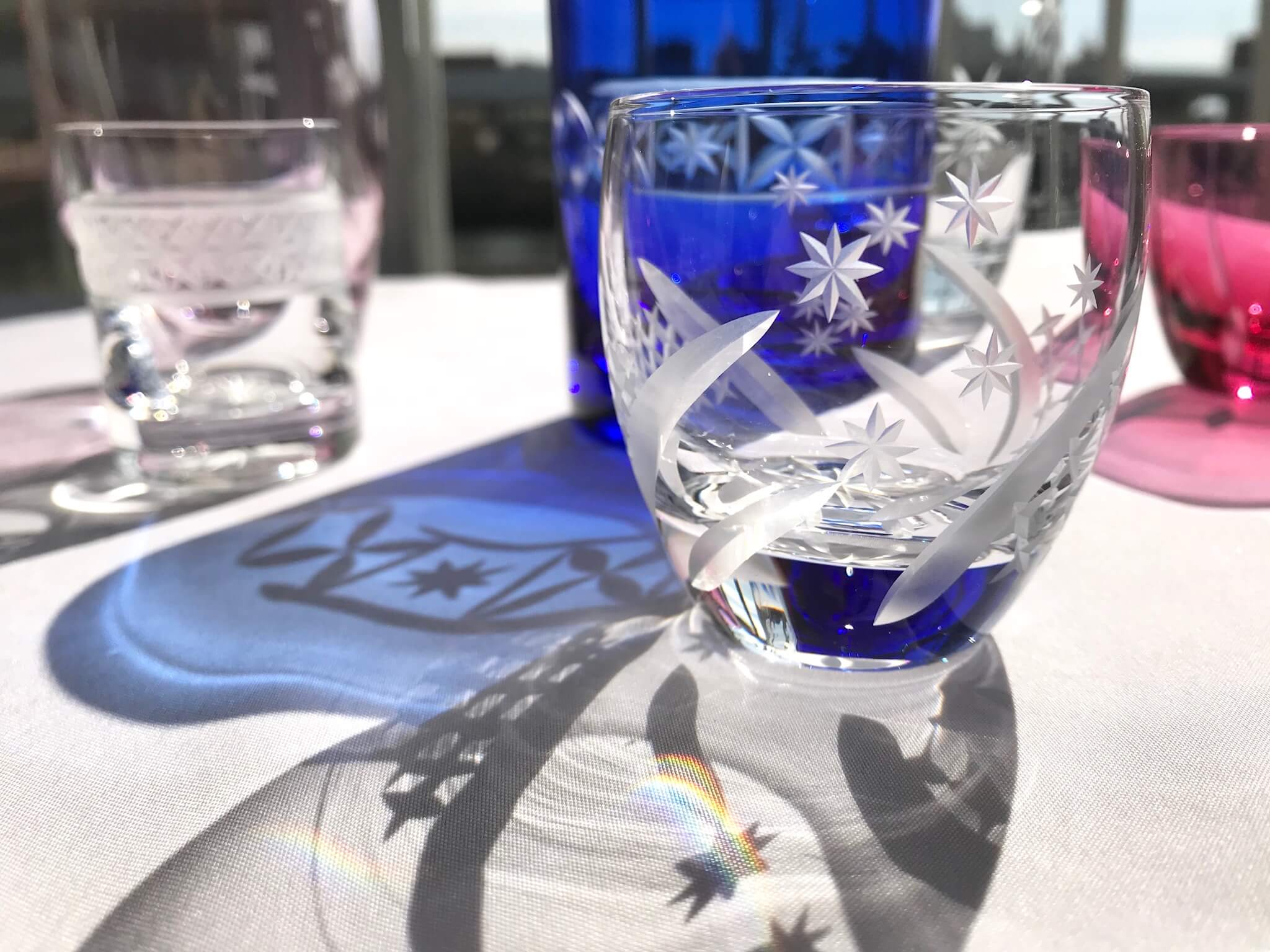
The Edo Kiriko plan gives you the opportunity to cut your own Japanese glass to drink from. You can drink from your glass if you reserve the plan with lunch or dinner.
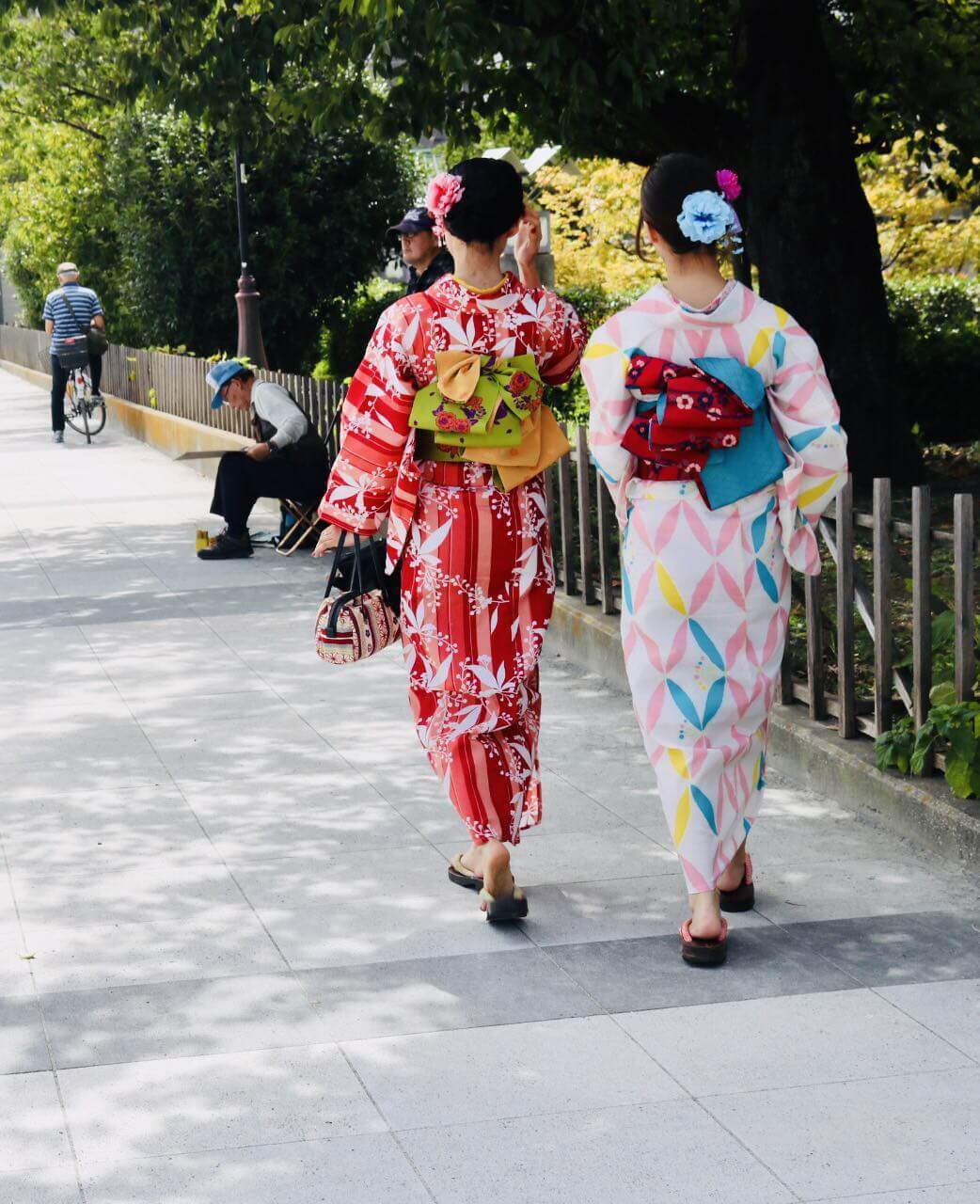
Finally, you can rent a kimono. Select your favourite from the shop and have a professional dresser get you readyーwith both your kimono and your hair. After you’re dolled up, you can take a stroll around Asakusa to get a real feel for Japanese culture.
All three of these plans are just ¥3,500 per person, and all require reservations which you can book online.
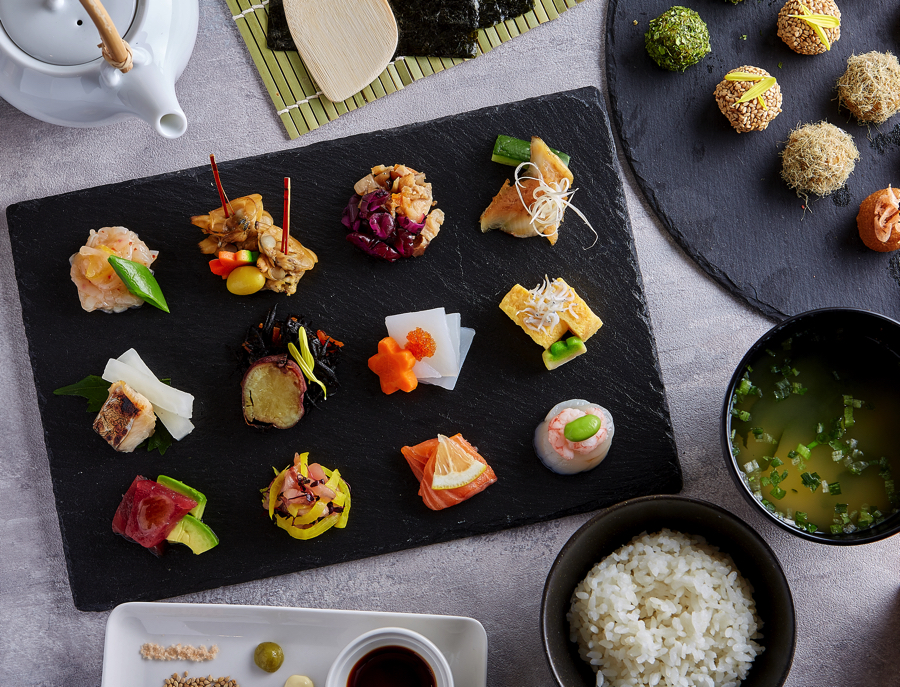
So, if you’re looking for a taste of Japanese food and culture, why not take a trip to WASHOKU when visiting Asakusa for an all-in-one experience?
Information
Taikenkei Dining -WASHOKU-
Address: 2113 Kaminarimon Bldg. Floors 5F-6F, 2 Kaminarimon, Taito Ward, Tokyo
Opening Hours: Lunch 11:00-15:00 / Dinner 15:00-17:00
No Fixed Holidays
Access: 1-minute on foot from Exit 4 of Asakusa Station via the Tokyo Metro Ginza Line / 2-minutes on foot from Exit A3 of Asakusa Station via the Toei Asakusa Line
Official Website (English): https://washoku.site/en/
-
IOC and Airbnb Announce Global Olympic Partnership & Olympian Experiences
The International Olympic Committee (IOC) and Airbnb have announced a major long-term partnership to support the Olympic Movement which will run from 2020-2028. During this period, Airbnb will offer unique accommodation and experiences, and experience tours hosted by Olympians and athletes will also take place.
The partnership will create hundreds of thousands of new Airbnb hosts over the the nine-year period from July next year, allowing for visitors to enjoy longer stays, accommodating families, and more. This will enable community residents to generate extra income while accommodating overseas visitors and proving them with local experiences. In turn, it means those visiting from overseas will be able to engage more with the local culture and community. Both occupied and vacant homes will be utilised.
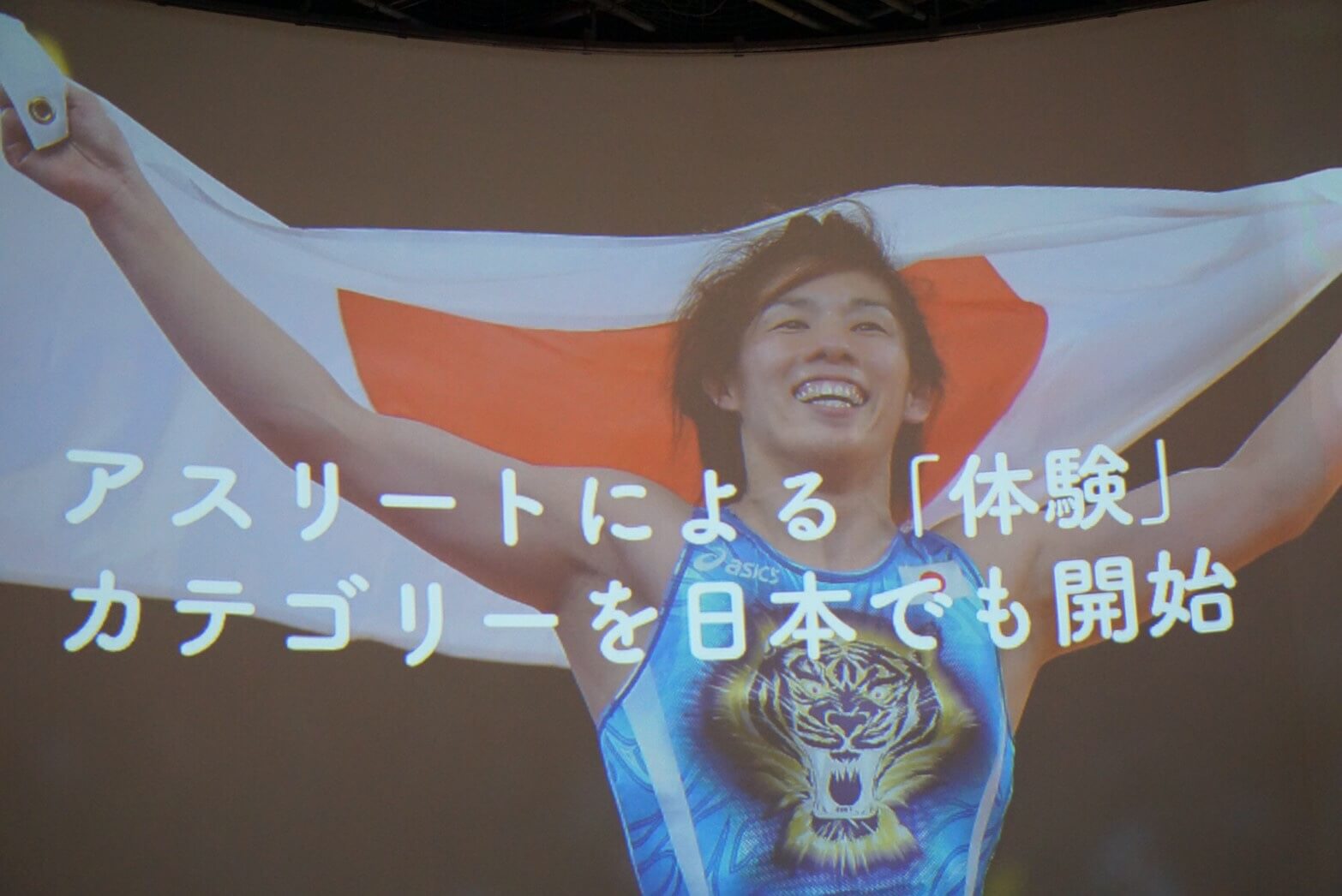
The IOC and Airbnb will also launch Airbnb Olympian Experiences which will provide direct earning opportunities for athletes by promoting sports, allowing for people to train together with elite athletes and Olympians.
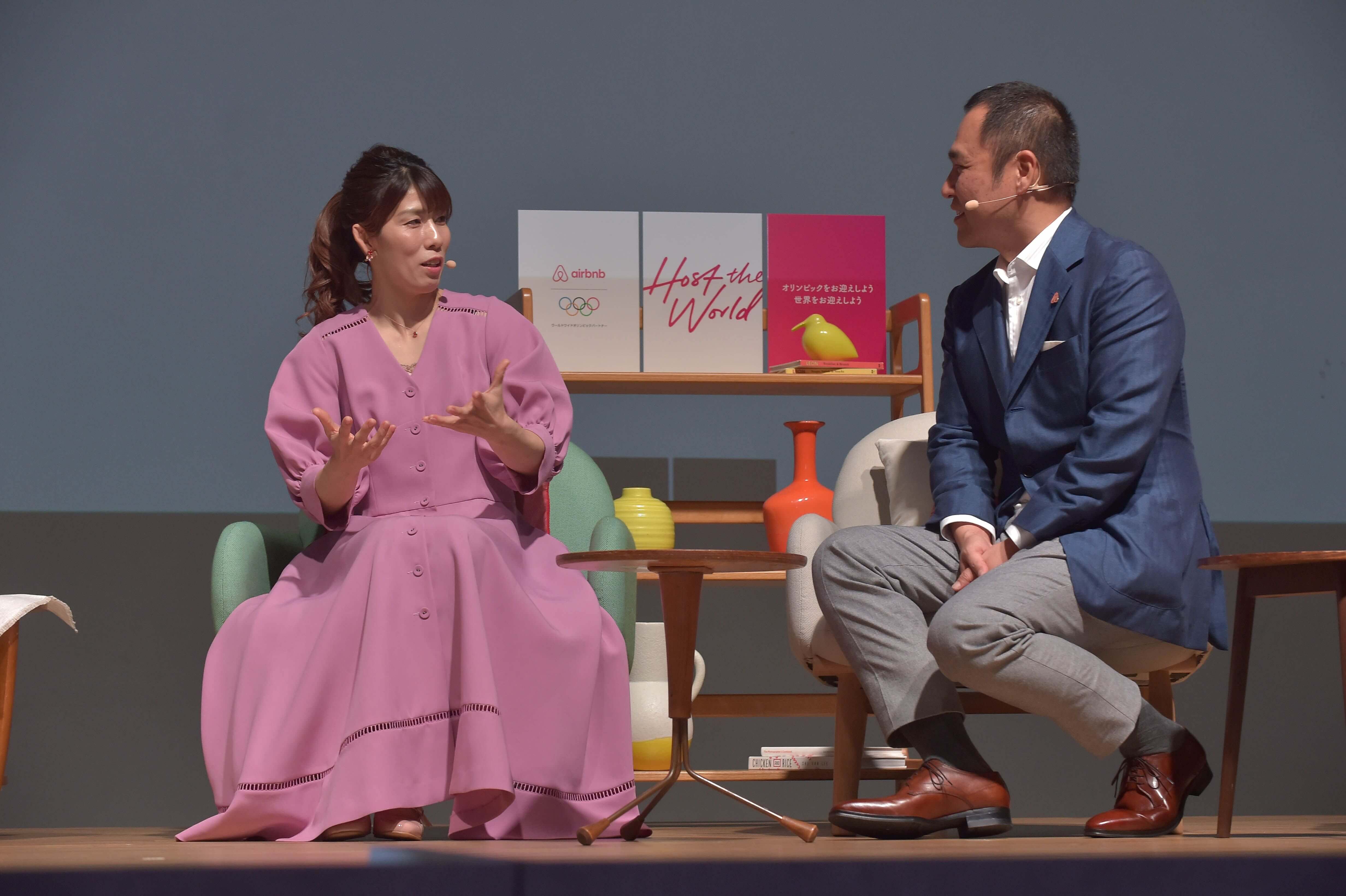
At the press conference for the announcement of the partnership, gold medalist Saori Yoshida said: “A lot of athletes today devote themselves completely to the games, so a lot of them struggle to find their next career after retiring. These Athlete Experiences will widen the activities of all athletes; not only retired competitors, but those who weren’t able to make it as far as the Olympics too. I’m very thankful for that. I believe it will raise the standard of the games for kids, and will serve to brighten and bring excitement to the whole of Japan. I hope that these efforts bring a tremendous boost to the sports world and will have everyone taking an interest in sports.”
Tokyo 2020 will officially launch next summer, and with this partnership, people may just be able to enjoy the Olympic Games together with the athletes themselves, allowing for fans to feel closer to the games and the Olympians.
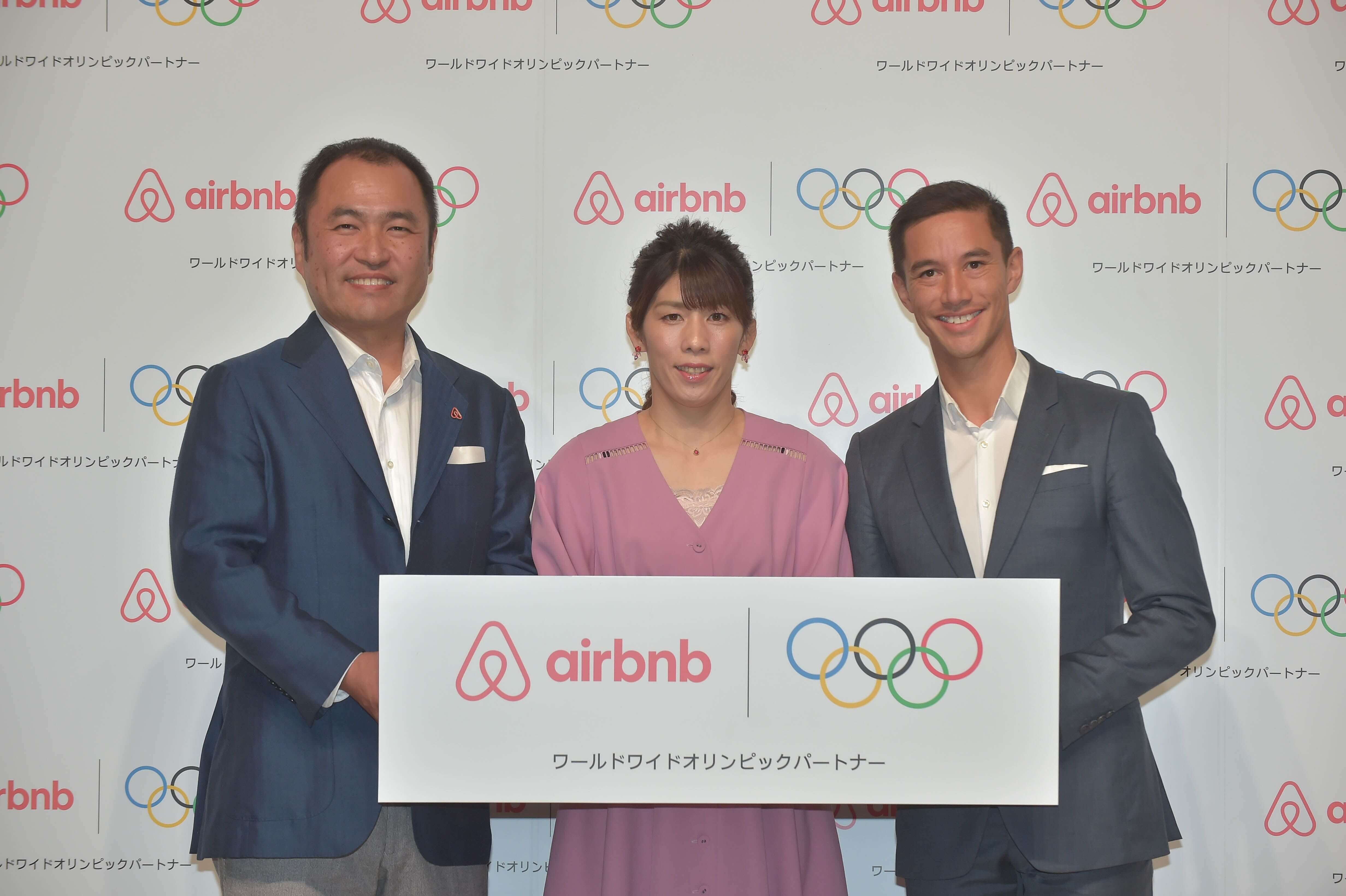
Airbnb’s involvement also gives visitors from overseas to enjoy Japan and the Olympics in an unprecedented way. If you’re travelling to Japan for Tokyo 2020, be sure to book with Airbnb.
Information
Airbnb Official Website: https://airbnb.jp
-
Stroll the Edo Streets as an Elegant Samurai and Make Tea in the Feudal Lord’s Residence
04.October.2019 | SPOT
Sakura, Chiba is home to important cultural heritage and even what is also known as the “Samurai Town”. Now you can stroll around the beautiful old streets of Sakura dressed as a Samurai, attend a relaxing zen session and even take part in a tea ceremony as part of a limited period tourist plan. The Samurai tour is mainly aimed at foreigners, however Japanese people who are curious about samurai culture are also more than welcome to join.
Sakura Castle Samurai Stroll
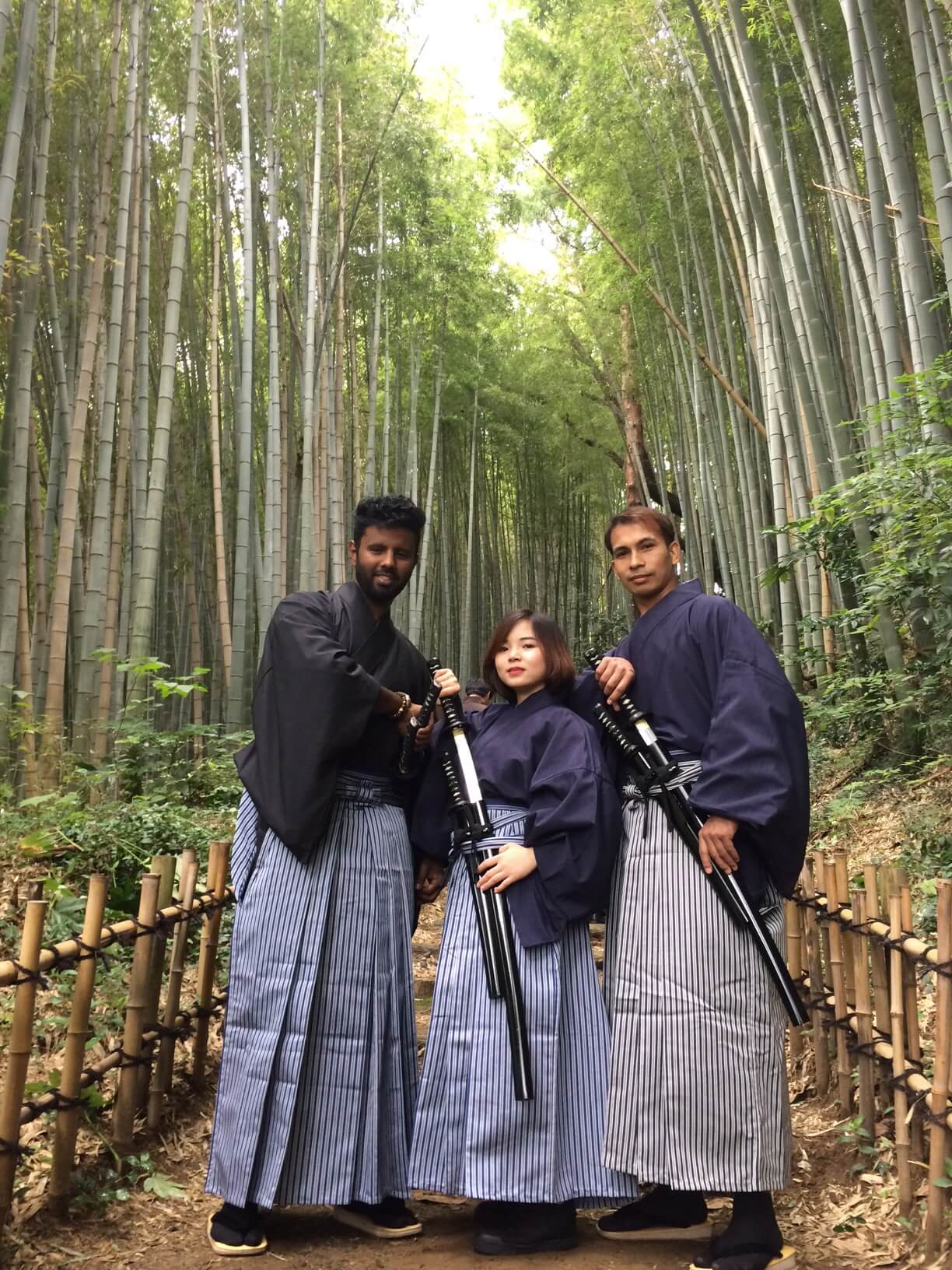
In 2016, Sakura became one of the four cities of the Hokuso region to be designated as a Heritage site under the title “An Edo Travelogue through Four Hokuso Cities” for its preservation of the old Edo culture. Old buildings full of secrets can be spotted all over the town, creating the old atmosphere of the Edo period. Embrace the elegant remnants of the Edo period with a relaxing stroll in Samurai clothing. Who knows what you might discover.
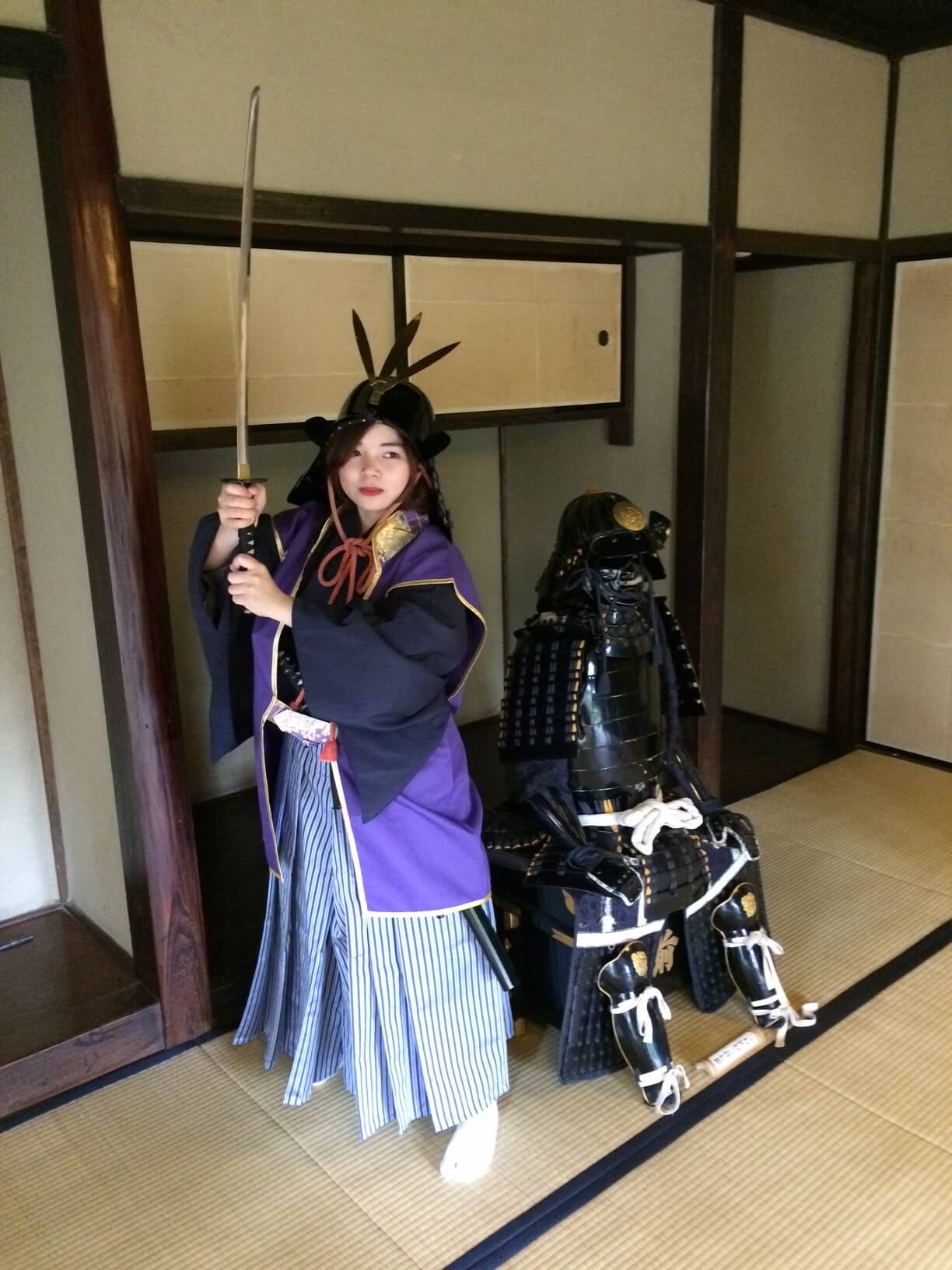
Your relaxing stroll will be led by a tour guide who knows a lot about the history of Sakura. This is a wonderful opportunity to take beautiful pictures of the historical Samurai house (Bukeyashiki). Your tour guide will also show you Hiyodorizaka, which is a natural path lined with a dense forest of tall bamboo trees where Samurai are said to have often pass by. Every year, the bamboo and wooden sword martial arts sessions in the program are also very popular.
◇ Running:
October 26
November 9, 23
December 14, 21
January 11, 25
February 8, 22
March 12, 28
April 9, 25
May 9, 16
◇ Times: 9:30 ー 12:30
*The program will still run in bad weather excluding stormy or severe weather.
◇ Prices:
¥6,500 per person (Includes lunch voucher and entry to the samurai house)
* ¥6,000 per person when you purchase tickets as a group of 3 or more.
◇ Tickets
Reservation Website: https://www.govoyagin.com/ja
Apply Directly to Sakura City Tourism Association
TEL: 043-486-6000
Email: sakurashi-kankou@catv296.ne.jp
* Phone calls will be answered in Japanese only.
Zen Meditation and Tea Ceremony in the House of a Feudal Lord
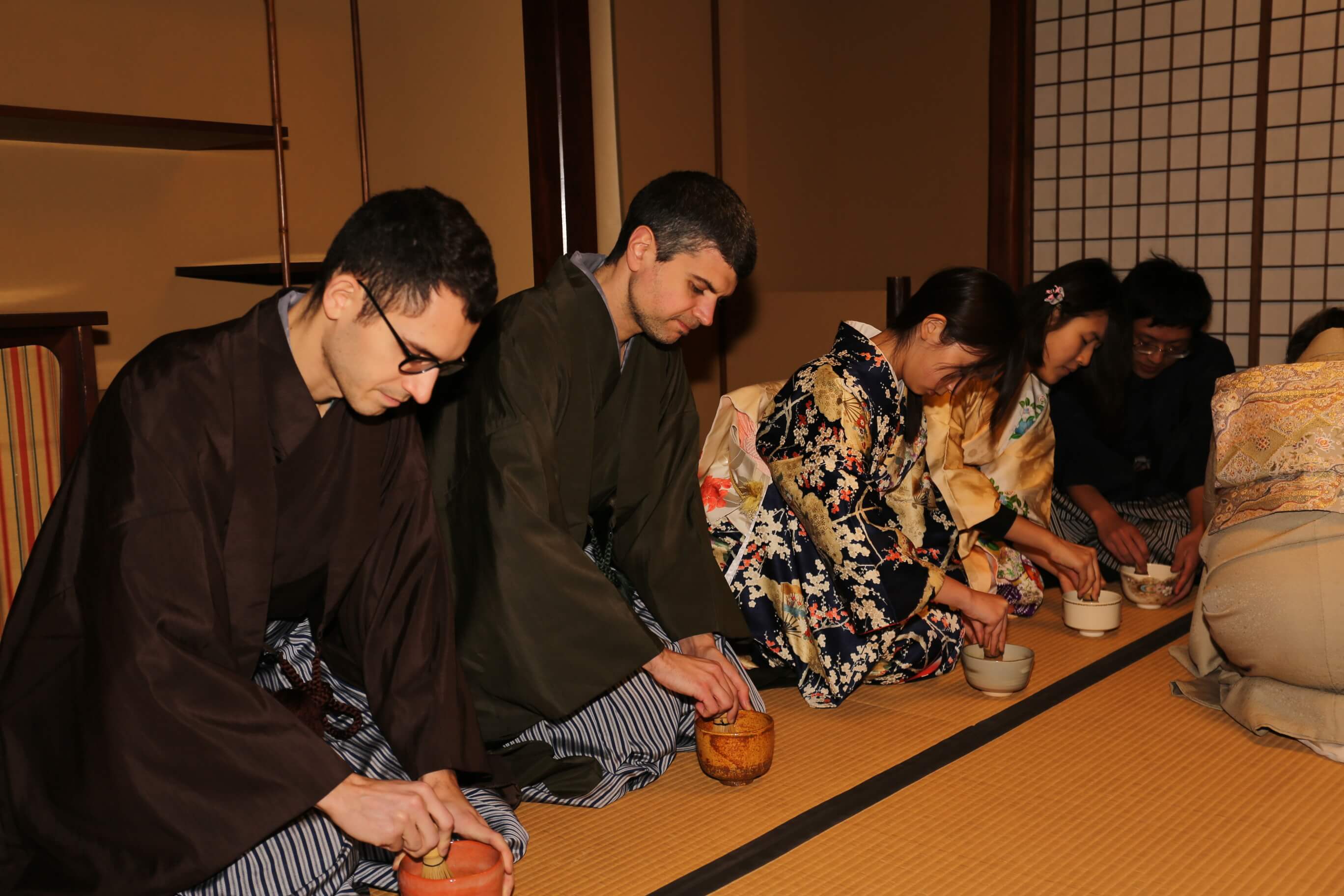
There are also guided zen meditation and tea ceremony sessions which are available for a limited period only. These guided zen meditation and tea ceremonies will take place in the Kyuhottatei ー one of Japan’s most preserved traditional-style feudal lord residences. This luxurious Edo-style mansion was built 130 years ago and is classified as an Important Cultural Property.
◇ Running:
October 16,
November 7, 19
December 6, 18
◇ Times: 9:00 ー 12:30
*The program will still run in bad weather excluding stormy or severe weather.
◇ Prices:
¥10,000 per person (Includes lunch voucher, entry to the Kyuhottatei and tea ceremony participation fee.)
◇ Tickets
Please enquire directly to the Sakura City Tourism Association
TEL: 043-486-6000
Email Address: sakurashi-kankou@catv296.ne.jp
* Phone calls will be answered in Japanese only.
If you are curious about Edo Samurai culture, you won’t be disappointed by this program.
Information
Sakura City Tourism Association
TEL:043-484-6000
URL:https://www.sakurashi-kankou.or.jp/
-
Taste Different Japanese Teas in Wine Glasses in Fukuoka
27.September.2019 | FOOD
Neworld has teamed up with Asakura, Fukuoka-based tea manufacturing company Seichajo Yamashina to offer an all-new tea-tasting course. Reservations opened on September 25 and can be made via telephone call.
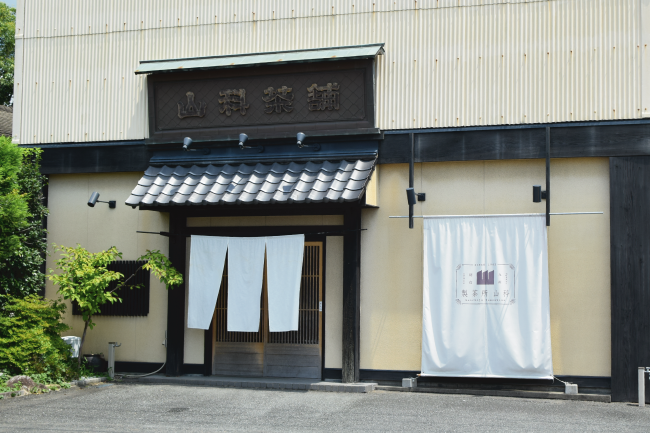
Yamashina Tea Stall first opened its doors to the public back in 1947 in the city of Asakura, Fukuoka. This long-standing tea shop oversees every aspect of their original blends, from the tea leaf selection to the roasting.
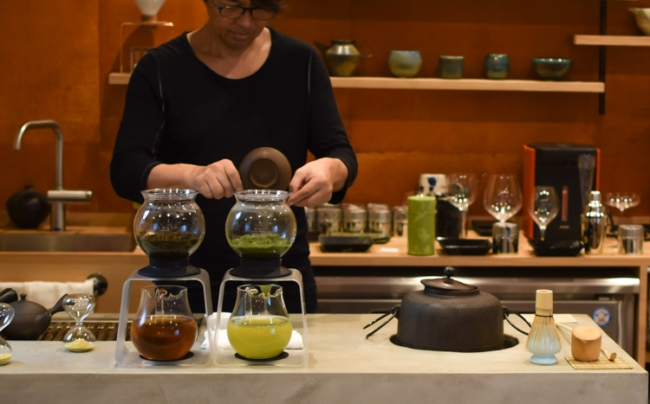
The shop’s representative, Koya Yamashina, is a tea professional, having worked as an instructor on Japanese tea as well as an established Japanese tea critic. He has travelled up and down Kyushu―one of the five main islands of Japan where Fukuoka sits―which has enabled him to select only the best tea for the shop, considering the taste, smell, season, place of production, and growers themselves.
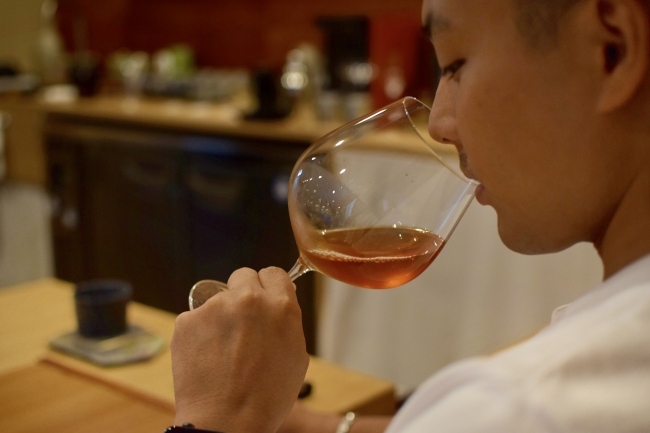
Yamashina Tea Stall promises a fun and authentic experience when it comes to Japanese tea, for the very fact that it has had its hands on so many different types. That’s where their new program comes in to play, where they will pair different Japanese teas into different wine glasses―provided by Tokyo glass makers Kimura Glass―for tasters to get the best out of the tea, including the flavours and fragrance.
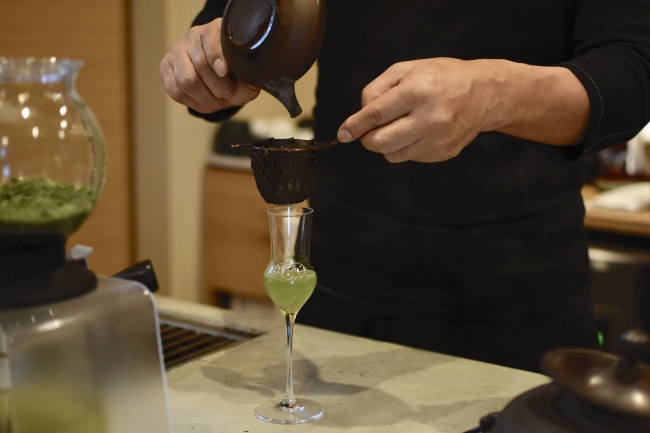
Let’s take a look at the course.
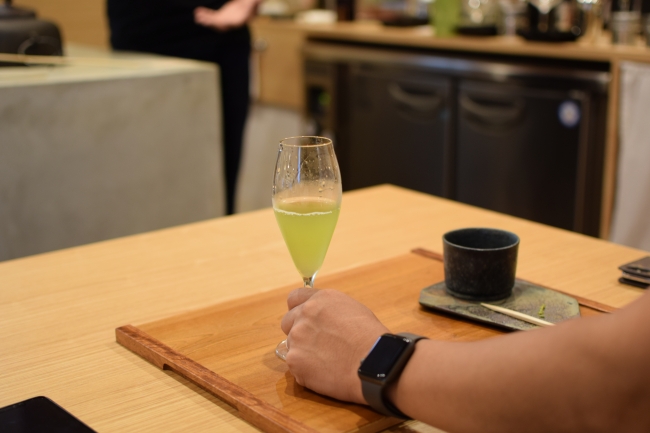
Piccolo 6oz Flute & Yama no Asatsume
This brand of tea is called Chiran Yama no Asatsume and it comes from Kagoshima Prefecture. It’s grown in Ushirodake, an area in Kagoshima with a high altitude, the only place it can be grown. It has a distinct fresh and sweet fragrance. The tea is served in a 6oz Piccolo glass which is a popular glass for champagne. Its delicate rim and form makes it the perfect shape to enjoy the full taste of the tea.
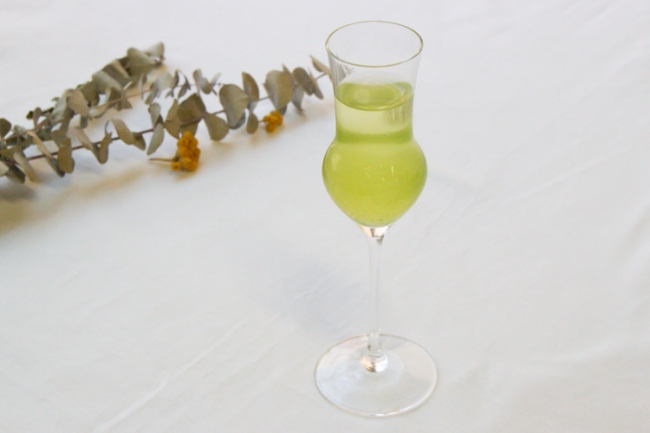
Garson 3oz Grappa & Yame Gyokuro
Yame Gyokuro is known as one of the most luxury teas in Japan. Served in a Garson glass, it has a thin, long shape, making it ideal for smelling the gentle aromas of the gyokuro tea and for enjoying its smooth, sweet taste.
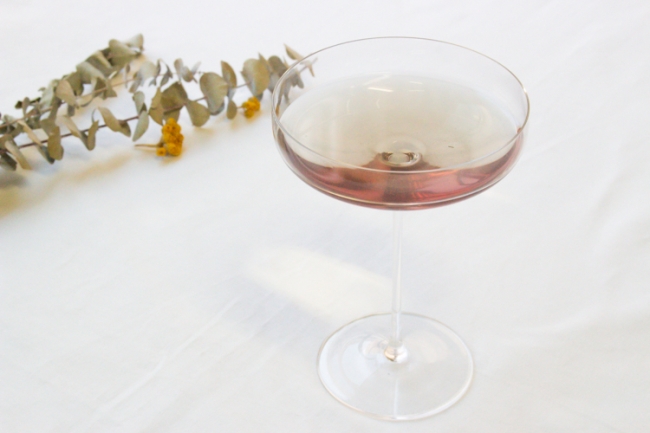
Pivo Orthodox 63224-210 & Sun Rouge
Sun Rouge is an extremely rare variety of tea grown on the distant island of Tokunoshima which is south of Kagoshima. It is served in a classic champagne glass, much different from the flute-type champagne glasses. The liquid is allowed to spread over a wider surface, letting you take in the distinct beautiful purple colour of the tea while enabling the fragrance to dance around the elegant glass.
This is just a snapshot of the many drinks this course has to offer. If you’re looking to experience Japanese tea in style, then why not try out this course? They even sell sets of glasses and tea so you can take them home with you!
Information
Yamashina Tea Stall
Address: 1635 Amagi, Asakura, Fukuoka
Opening Hours: 10:00-18:00
Course Name: CRAFT STORE x Seichajo Yamashina Japanese Tea Course (5 Types)
Price: ¥1,800
Reservations: Telephone (Limited number of places, please enquire ASAP)
TEL: 0120-177-515
Homepage: https://www.e-ochaya.net/
-
Keio Plaza Hotel Tokyo Offers Luxurious Accommodation Plan & Tea Ceremony Experience For Families
05.August.2019 | SPOT
Keio Plaza Hotel Tokyo, a highly prestigious and magnificent 4-star hotel located in Shinjuku, is now serving an all-new “luxurious” family package which includes a tea ceremony experience and much more. It is currently running from July 20 to September 1.
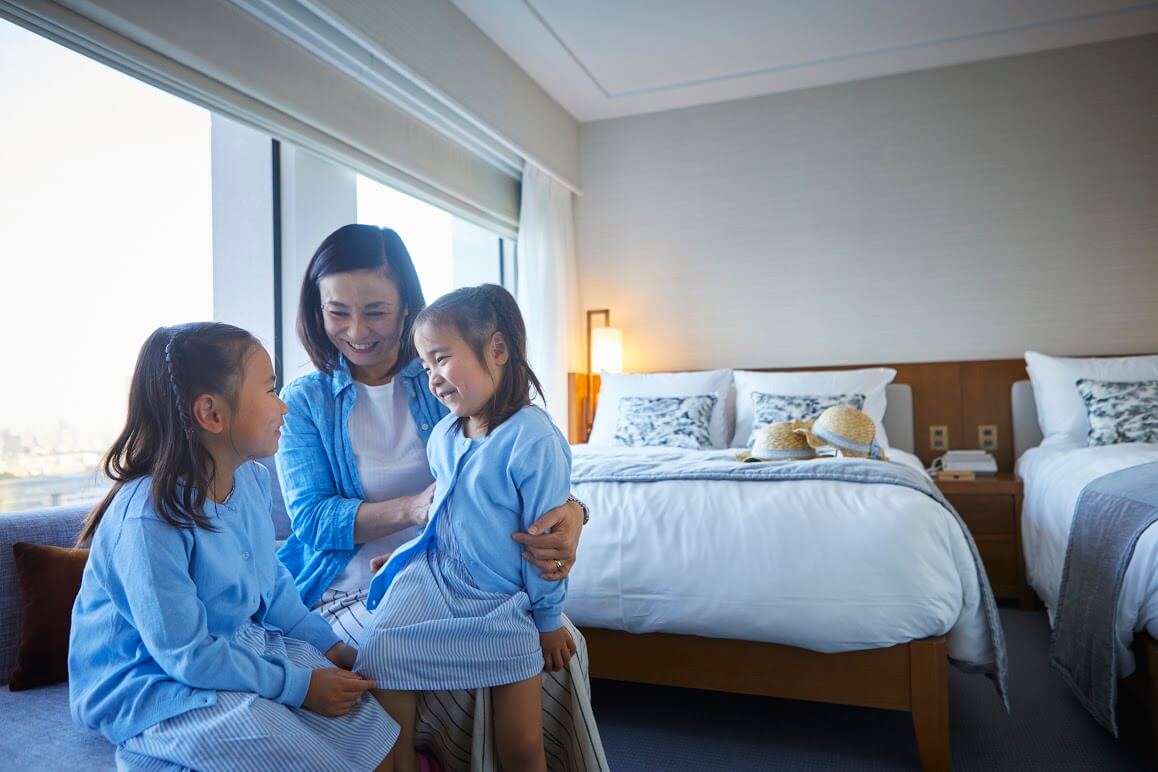
The rooms offered in the accommodation plan are the hotel’s popular Wide Twin Rooms located on the Premier Grand club floor. Use of the Club Lounge is included in the package. The Wide Twin Rooms include two roomy queen-size beds which span 1.53 meters wide which allow parents to sleep comfortably with their children. Rooms also feature their own bathroom facilities.
The package also includes a check-in simulation for children aged 6-12 years where they can get a feel for what it’s like to check-in. They will fill in their own check-in cards with parents and receive a ticket for the tea ceremony experience. They will be able to take their card home with them and take a commemorative photo.
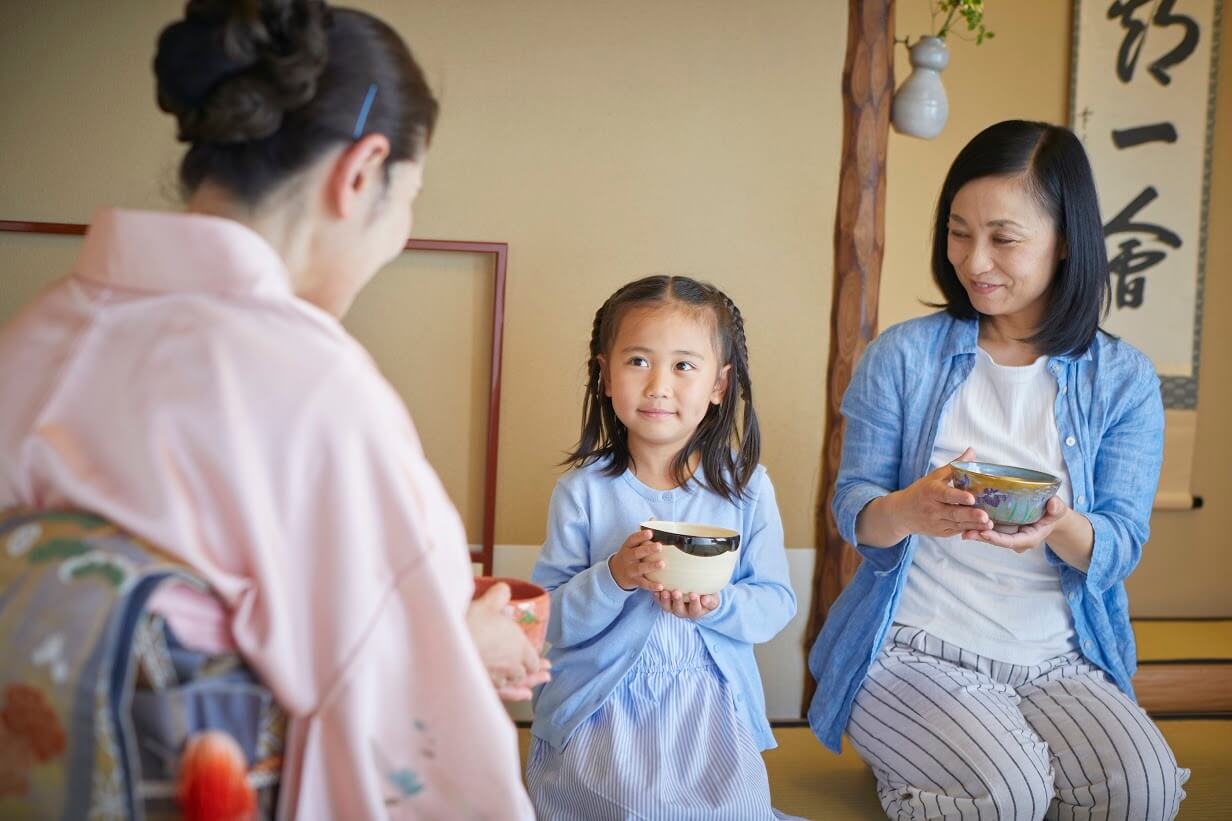
The tea ceremony experience will be held on the hotel’s 10th floor in the “Shofuan,” an authentic tearoom that has been in the hotel since it opened in 1971. Parents and children will receive proper instruction from the tea ceremony teacher before pouring their own tea, allowing them to learn about traditional Japanese culture and etiquette. They will receive a special certificate of completion at the end.
If you’re travelling to Japan as a family this summer then enjoy it in luxury at Hotel Keio Plaza Tokyo.
Information
Tea Ceremony Experience and Luxurious Accommodations for Families
Running: July 20, 2019 – September 1, 2019
Price: ¥18,450 per person for the Wide Twin Rooms on the Premiere Grand Club Floor *Usage for 2-4 people (Includes use of the Club Lounge, breakfast, and includes service charge and tax)Package Includes:
①Tea Ceremony experience for overnight guests (1.5 hours required, children of preschool age or younger cannot participate but are welcome to watch)
②Simulated Club Lounge check-in experience for children and special commemorative photographs available between 2:00p.m. to 5:00p.m.
③Amenity items for mother use (skin care products etc.)
④Commemorative certificates of stays and tea ceremony completion, and photographs presented to guests
⑤Complimentary late check-out at 12:00p.m. (Normal check-out time is 11:00a.m.)
⑥Complimentary use of Sky Pool facilities
Enquiries & Reservations: +81-35322-8000
Keio Plaza Official Website: https://www.keioplaza.com/
-
Explore The Hidden Beauty, Culture And Local Cuisine Of Hida Takayama In A Yukata
18.July.2019 | SPOT
Shimocho is one of the districts of Hida Takayama and is overflowing with traditional culture that you absolutely must experience. To make the most of your trip, there is a summer yukata-wearing programme running from July 20th which is the perfect opportunity to wear cooling and refreshing Japanese clothes while strolling and exploring the streets.
This year will be the 7th time the programme has been run. The Hida Takayama de Nippon no Natsu Yasumi programme allows visitors to dress in a comfortable and cooling yukata, stroll, explore, try different foods and enjoy the culture of the area. This year’s theme is “romance and yukatas” and gives visitors the opportunity to enjoy programme-limited desserts and the rich culture of the district.
Discover Hidden Beauty with the Stroll Map
Visitors will be given a map packed with wonderful spots of the area. The map will also include the destinations of 31 shops where you can enjoy special experiences, meals and desserts that are limited to those who take part in the yukata programme. Recommended spots to visit are also drawn on the map in a very cute handwriting-like style, so you can stop by these places easily while enjoying your walk. There are even many places on the map that only a local would know about.
Some of the special benefits of the programme allow you to enjoy the best regional cuisine that Hida has to offer, including the wonderful experience of restaurants that have been loved by the locals for generations, a beef delicacy restaurant, and much more. Besides food, the programme also gives you the opportunity to witness the beautiful festival floats used during the Takayama festival at the Takayama Matsuri Yatai Kaikan. You can also enjoy experiencing baking your own senbei crackers and gold panning.
The programme includes a wide range of experiences for you to enjoy from local shops to food to culture to some new experiences.
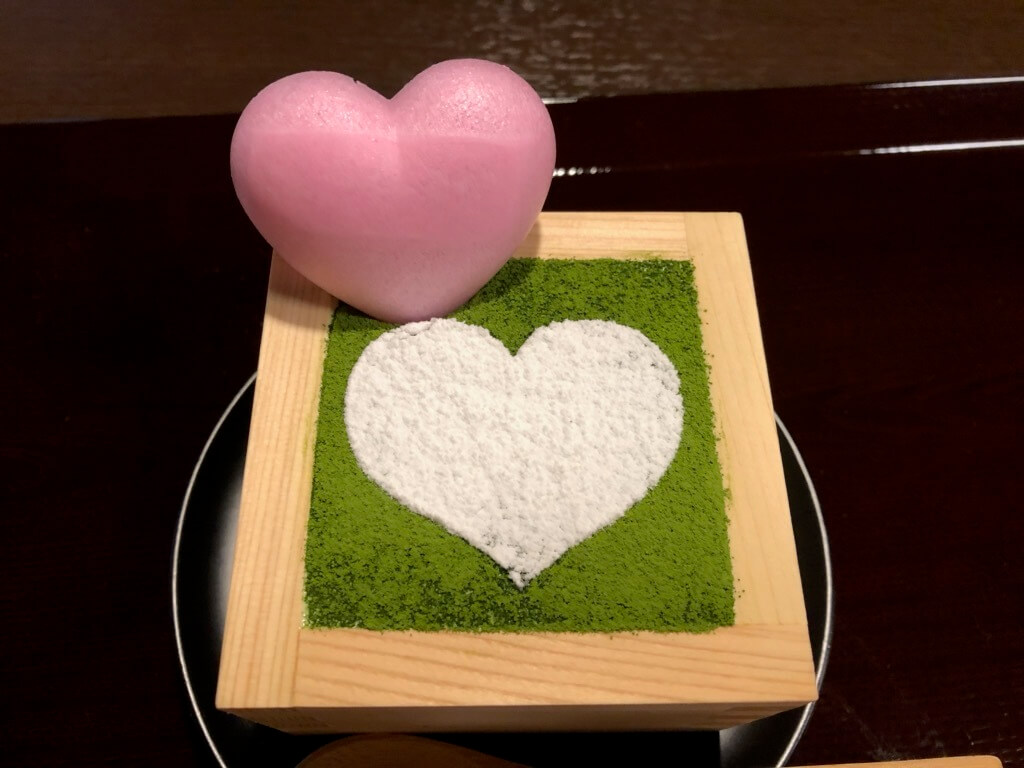
An old-style café called Sabou Usagi is particularly popular with the locals. Here, the coffee is made using a vacuum coffee maker. With the summer programme, you can enjoy the delicious heart Tiramisù served here.
The stroll map includes a variety of locations such as the Takayama Tourist Information Centre, Hida Takayama Tourism Convention Association, Hida Takayama Travel Hotel Association and much more. The map also includes some of the accommodations available around Takayama, some important train stations and much more. You can easily download this map from the official website. (Japanese only )
Stroll the Streets in an Elegant Yukata
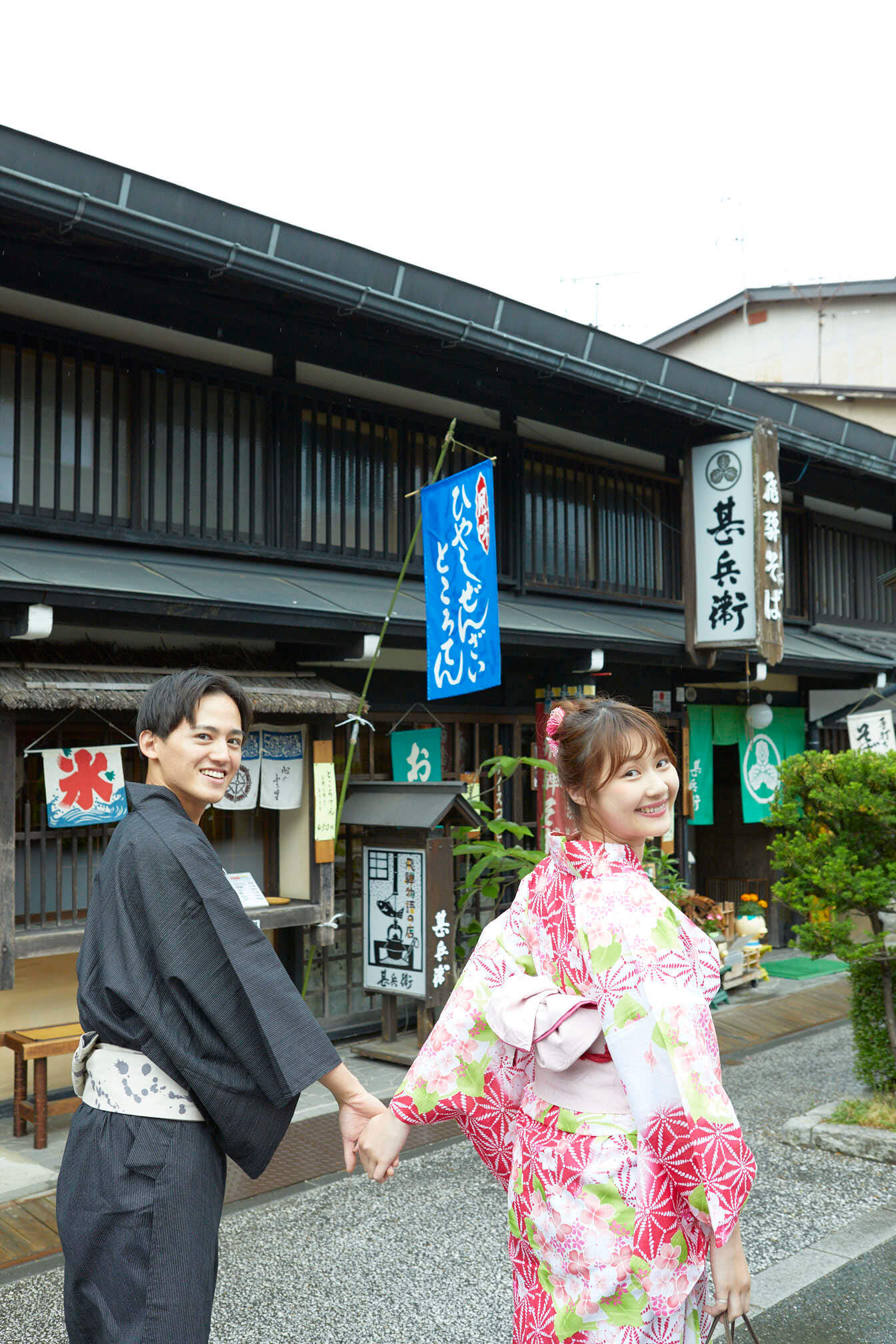
Change into a traditional Yukata that matches the beautiful surrounding townscape. There are four shops Yukata rental shops available to pick up your favourite Yukata, so there is no need to worry if you did not come prepared. There are also some accommodations that allow for yukata rental.
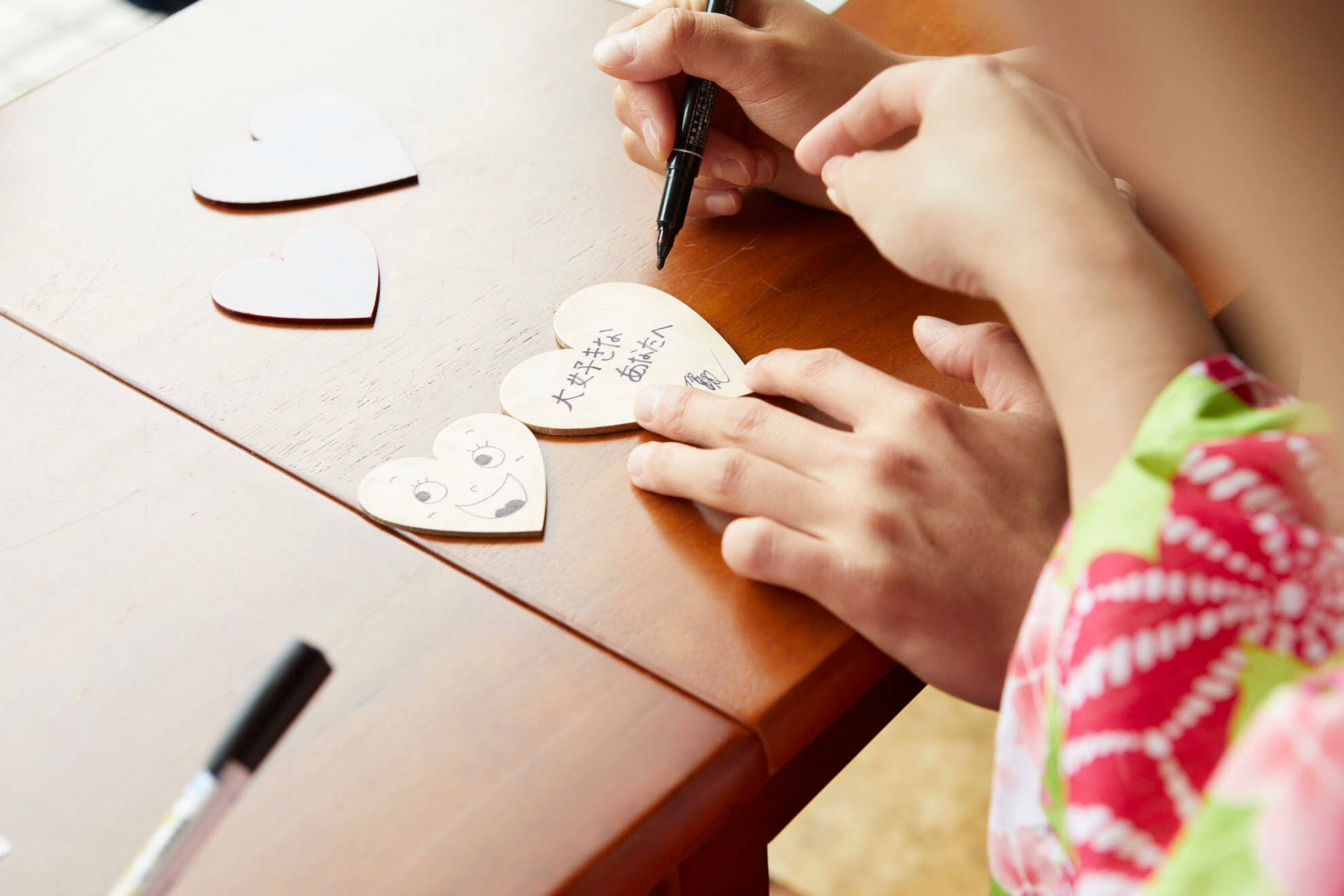
If you decide to join the Hida Takayama Nippon Natsu Yasumi programme, make sure to share your beautiful memories on Instagram with the hashtag #Hidasummer
Information
Hida Takayama de Nippon no Natsu Yasumi Programme
Running: July 20 ー September 8, 2019
Location: Shimocho, Takayama (in the general area of Sakurayama Hachimangu Shrine, Kamiichinomachi, Takayama, Gifu)
Official Website: https://hida-natsu.jp/
-
Tokyo Stroll: Shopping & Sightseeing with Mozuku-kun the Dog #5 – Uzumako Ceramic Art School
It’s been a minute since we last ventured out with Japanese model Yuna Yabe and her beloved pet pup Mozuku. If you’re new to this feature, Yuna Yabe takes her trusty partner Mozuku to various hot spots in Japan that you can enjoy with your pet dog. Their relationship continues to deepen in this priceless experience.
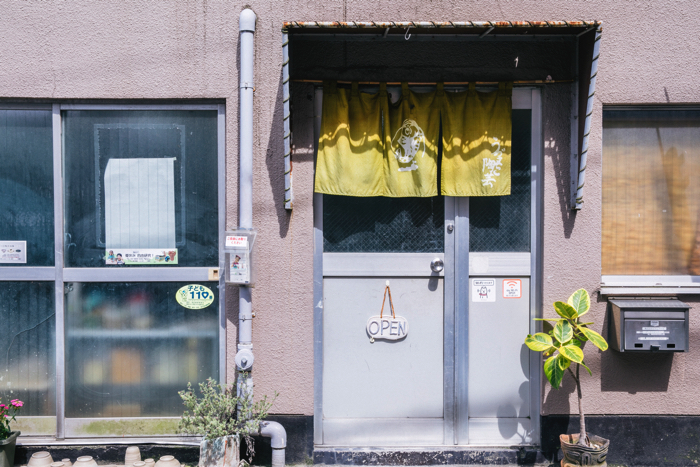
Today, Yuna and Mozuku head to Uzumako Ceramic Art School which is close to Shiba Park. You can get a good view of TokyoTower from this famous park.
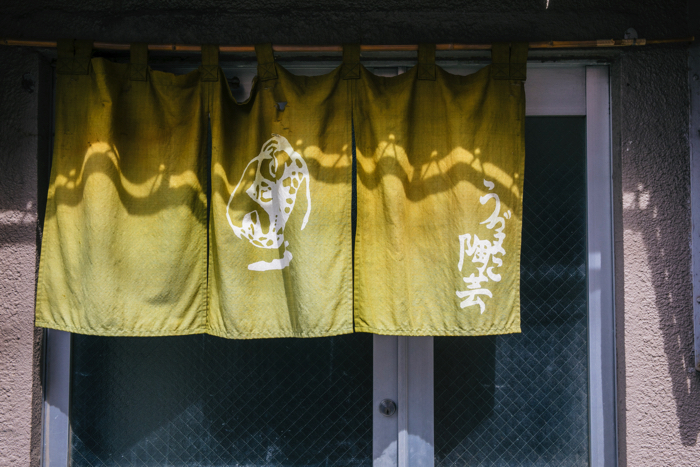
What’s unique about this art school is that visitors are allowed to take their pets with them. So this means you can take your dog with you to do some ceramics!
Yuna has always had an interest in ceramics. And what better way to experience creating something than with her partner in crime Mozuku! With him tottering beside her, she headed through the entrance curtain with a spring in her step.
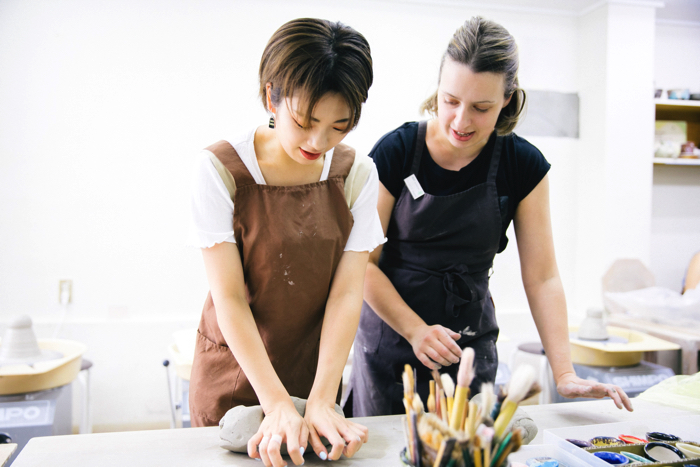
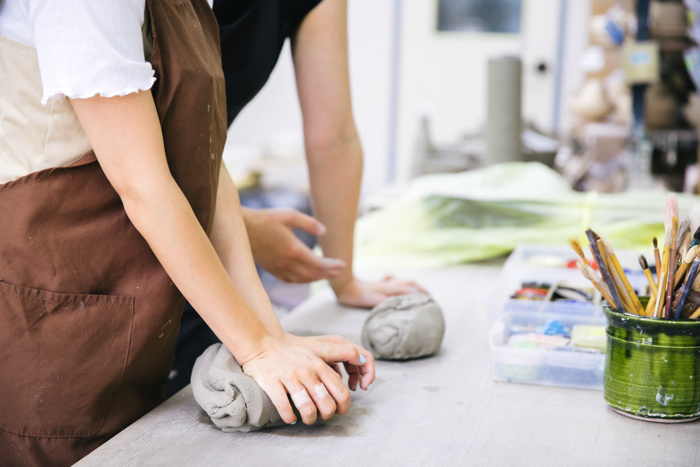
When you enter the classroom, there are lots of examples of pottery ware lining the shelves. The room has that smell of craftsmanship which lingers as you begin the class with a demonstration by the teacher. Once you have your apron on and are fired up to begin, it’s time to start.
The work begins with kneading the clay to make its firmness uniform. This step helps prevent air bubbles from forming.
Yuna asked the teacher many different questions as she enjoyed kneading her clay. “Where does ceramic work originate from?” “What kind of things to other dog owners make when they come here?”
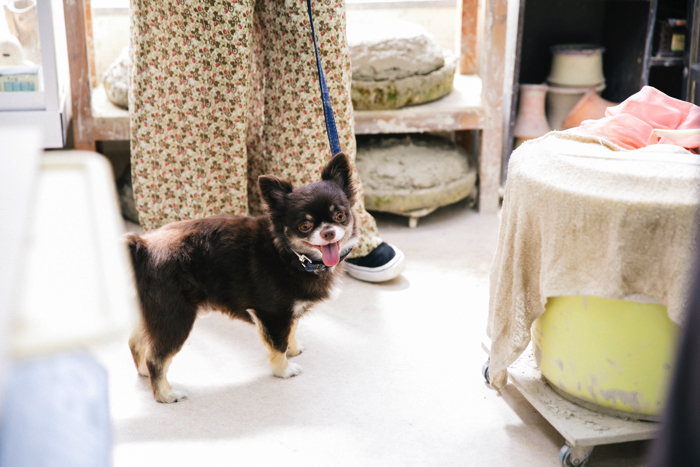
“What’s Yuna up to?” Mozuku’s puzzled face seemed to imply as he listened to Yuna and the teacher talk.
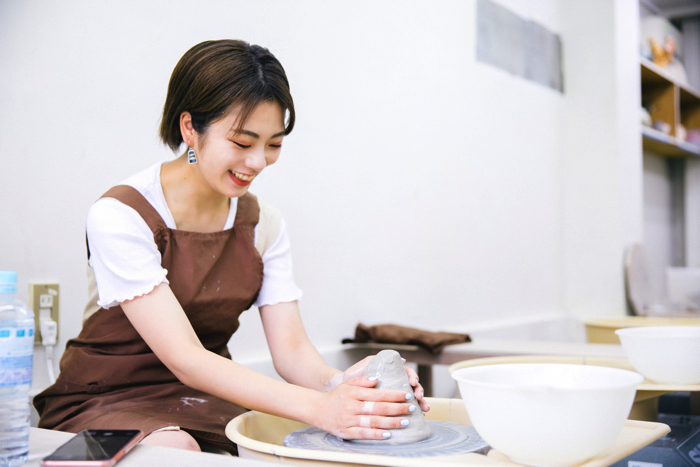
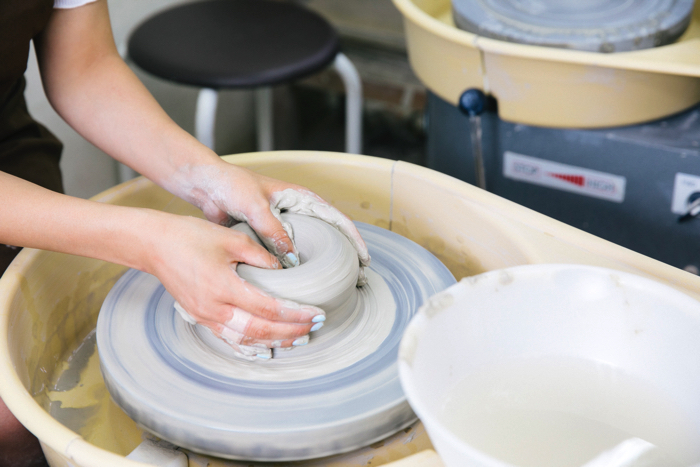
Yuna turned to Mozuku and said to him, “I’m going to make you a food bowl!” It seemed like the message got through as his face read, “Looks like my owner is making something just for me.”
Yuna wet her hands with some water and began forming a hole in the centre of her clay bundle. The hole forms and gets bigger as the pottery wheel spins.
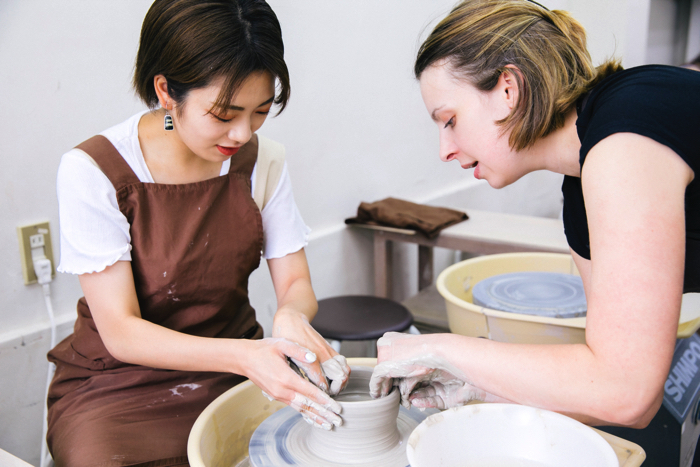
Next, she used both of her hands to ensure the thickness of the bowl was even all the way around.
“Amazing! The shape of the clay changes in an instant!”
By adding a little bit of pressure the pile of clay can change shape rapidly. It’s like a living thing.
“It’s like the clay is my own child. I wanna wrap it up!”
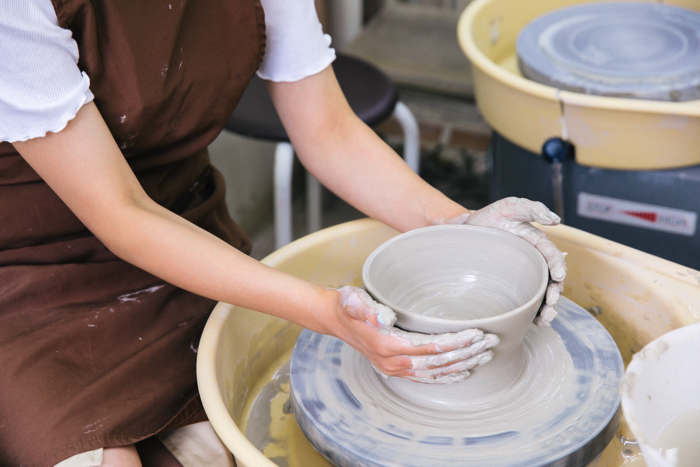
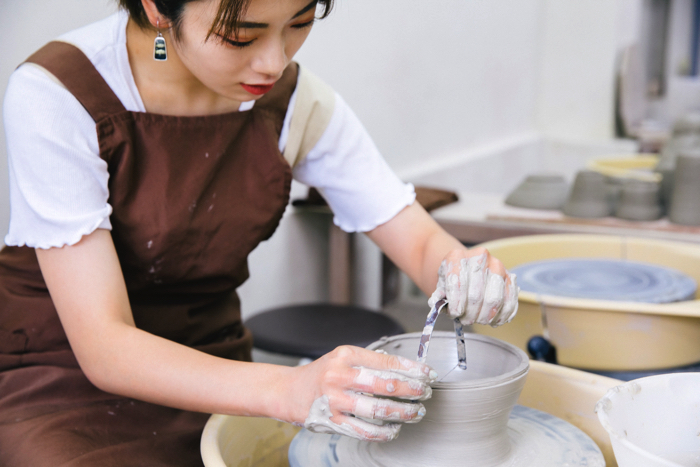
Once the shape is formed, Yuna cut around the edges. She is a skilled individual, she got the hang of it straight away.
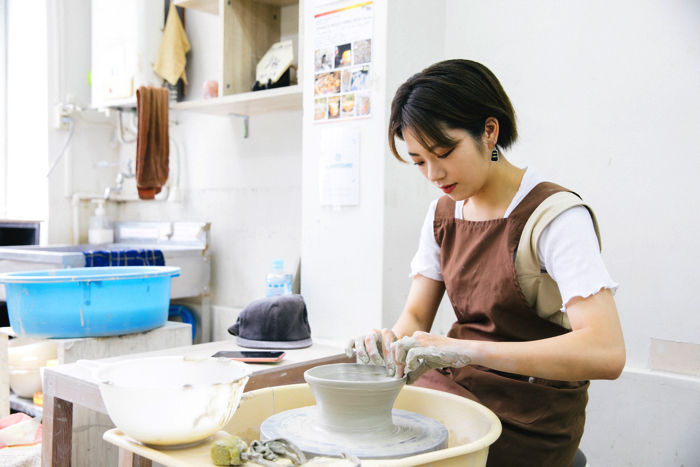
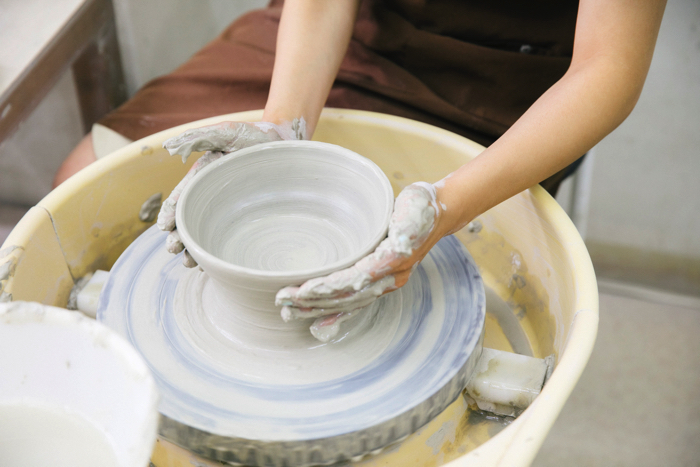
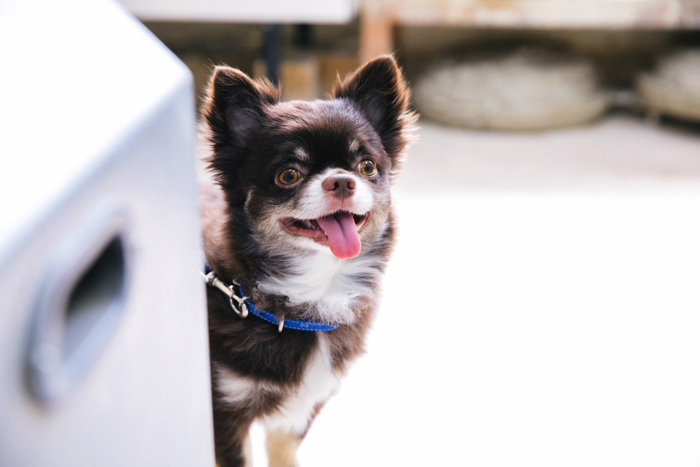
Mozuku sat right beside Yuna, quiet and curious.
“Is it my turn yet?”
He seemed itching to have a go at making something himself too.
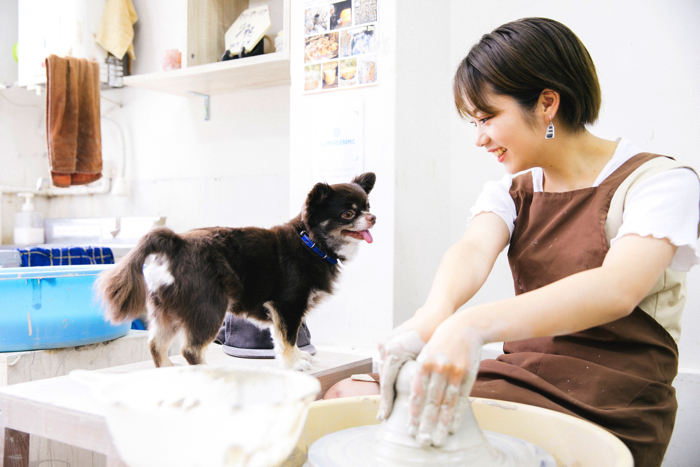
He watched over Yuna’s work from atop the table.
“I wanna try spinning the wheel too!”
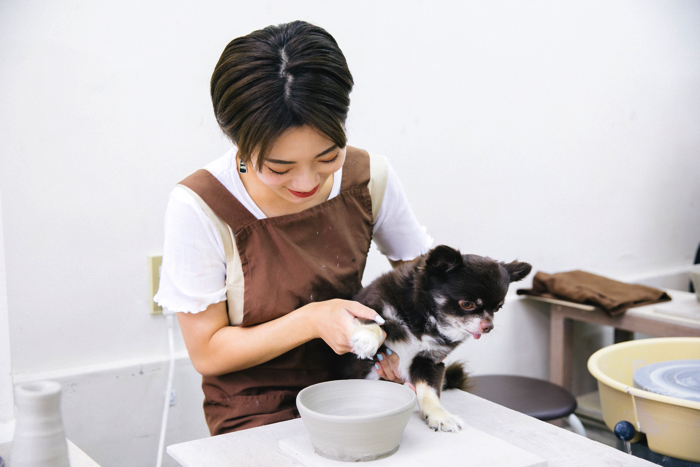
Mozuku in fact had the most important job of all. Yuna popped a wooden mould onto his paw and stamped a paw print into thebottom of the bowl.
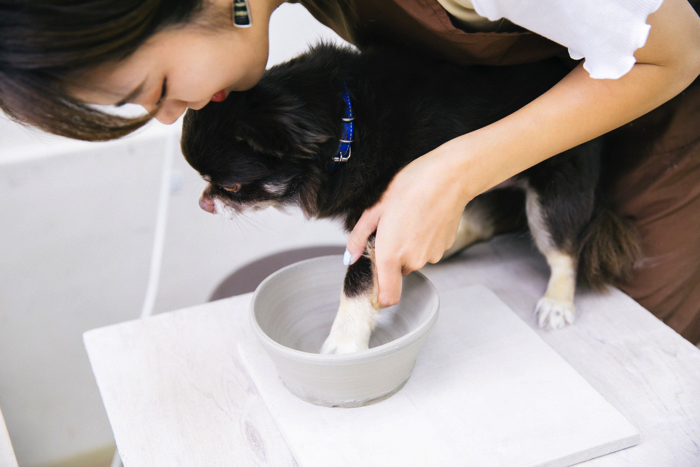
“There we go!” said Yuna
Mozuku mustered all of his strength to make his mark, his facial expression unusually serious as he carried out his big task.
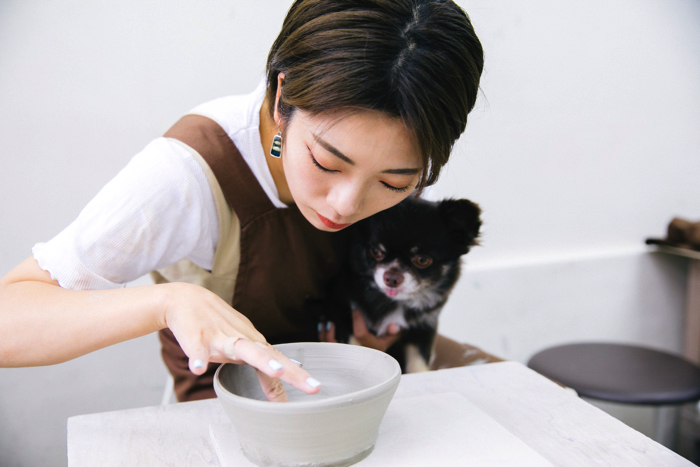
Time to check if the print was done properly!
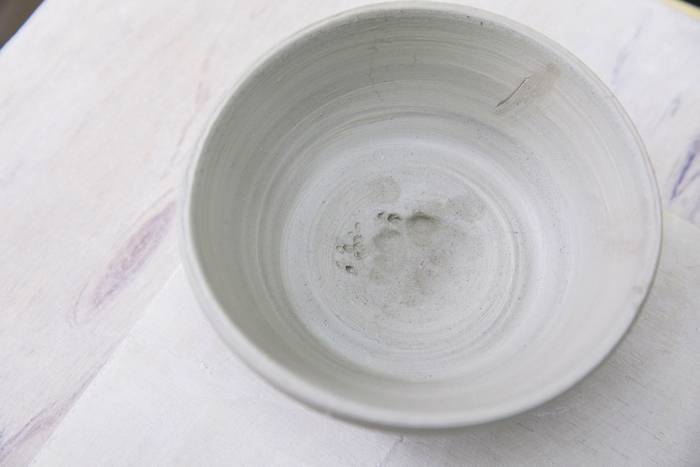
Here’s the final product―Mozuku did a great job!
Their teamwork paid off as they were able to create a really cute dog bowl. The tiny footprint is packed with pet love. The art school actually sells a lot of different cute and stylish pet items but the owner making their own makes it unique―the only one in the world.
If that love is able to get through to your pup, the food they eat from the bowl is sure to be even more delicious.
Thanks for your help, Mozuku.
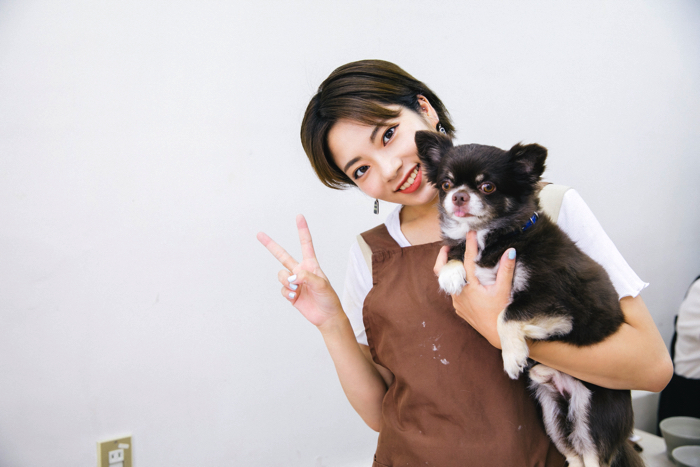
“I can’t wait to fire it!” Yuna’s excitement was peak from start to finish. She was very satisfied after the class finished.
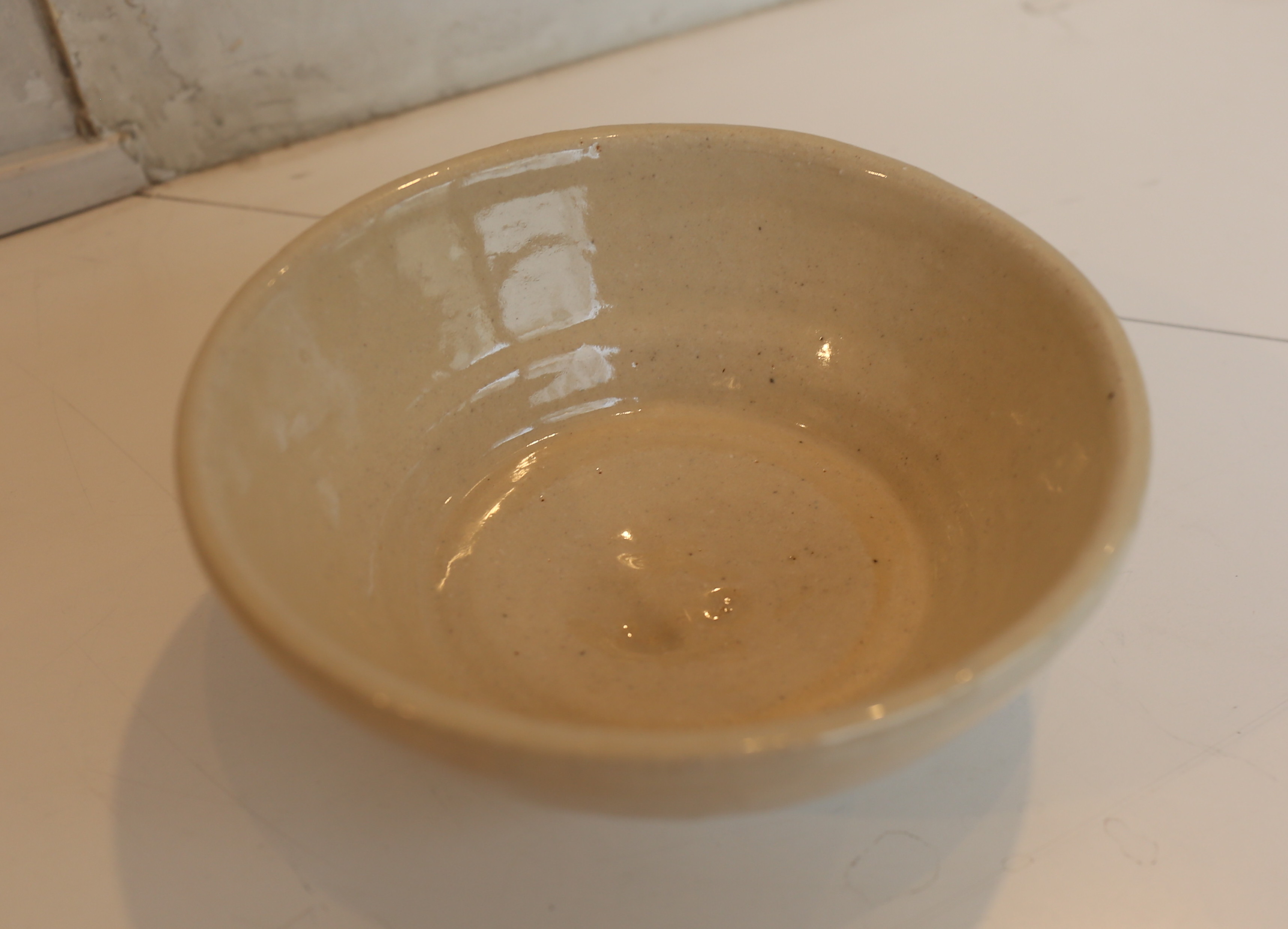
After two weeks of waiting, the bowl was completely finished.
Why not try creating something unique special for your own pet―together with them?
Model: Yuna Yabe/Mozuku @yunaaay1030
Text: Ai Watanabe
Photographer: Kayo Sekiguchi
Translator: Joshua Kitosi-Isanga
Information
Uzumako Ceramic Art School
Address: Sekisui House Floor 1F, 3-29-11 Shiba, Minato Ward, TokyoBusiness Hours: 10:00-19:00
Access: https://www.uzumakotougei.com/en/access.html
TEL: 03-6809-6363
Official Website: https://www.uzumakotougei.com/en/index.html
*The course Yuna took with Mozuku was the “Pet Ceramics Plan” where you can make 2-4 ceramic items and fire them. For your first try the staff will carve and glaze the final product to completion. This can be picked up one to one-and-a-half months after your course for ¥4,500. Please check the website for more details.
*Obedient dogs permitted. Please note that there are other participants so dogs who bark a lot or cannot relax are not permitted.
TALENT PROFILE
Yuna Yabe
Yuna Yabe won the grand prix prize at the “Zipper×ASOBISYSTEM Model Auditions” at the age of 15. She is an expert not only in fashion but make-up and video editing too. She’s an influential figure to the people in her generation. Recently, her work has expanded greatly, such as appearing in music videos. Her activity continues to grow and looks to be very promising indeed.
-
Visit Japanese Family Homes and Learn to Cook Authentic Japanese Food With airKitchen
30.May.2019 | FOOD
airKitchen is an online service gaining popularity by inviting foreigners travelling to Japan to experience what it’s like to cook at home there.
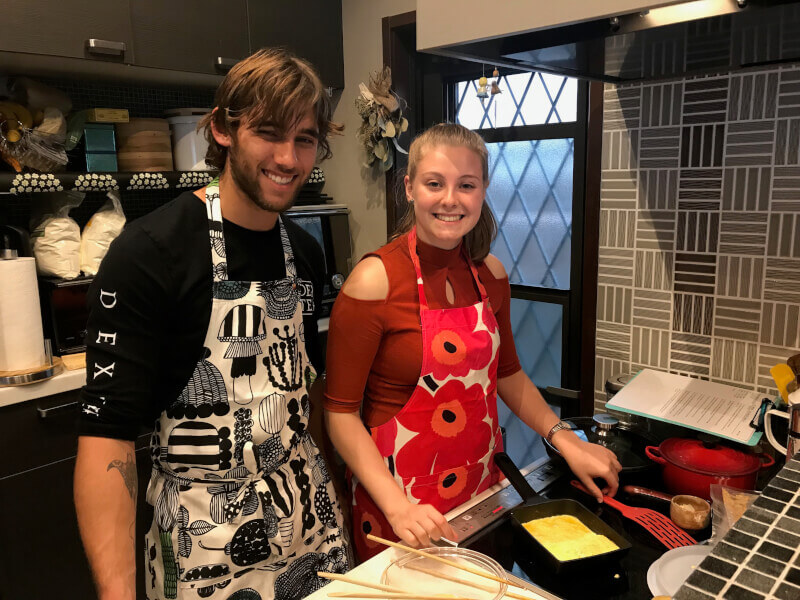
The number of foreign visitors to Japan has been on the rise in recent years, and with the Tokyo Olympics right around the corner, that number is predicted to continue increasing. One shift happening amongst travellers to the country is their desire for more experience consumption over material consumption. This shift has been noted by the Japanese government and companies who are pushing to offer more experience-based content to foreigners.
One such company doing just this is the online platform service airKitchen whose popularity is only continuing to increase. By using the website, foreigners can choose from a long list of Japanese hosts who will teach them how to make many different Japanese dishes in their very own homes. Bookings and payment can both be done via the company’s official website. airKitchen launched in April 2018 and by April this year it already has over 4,000 users.
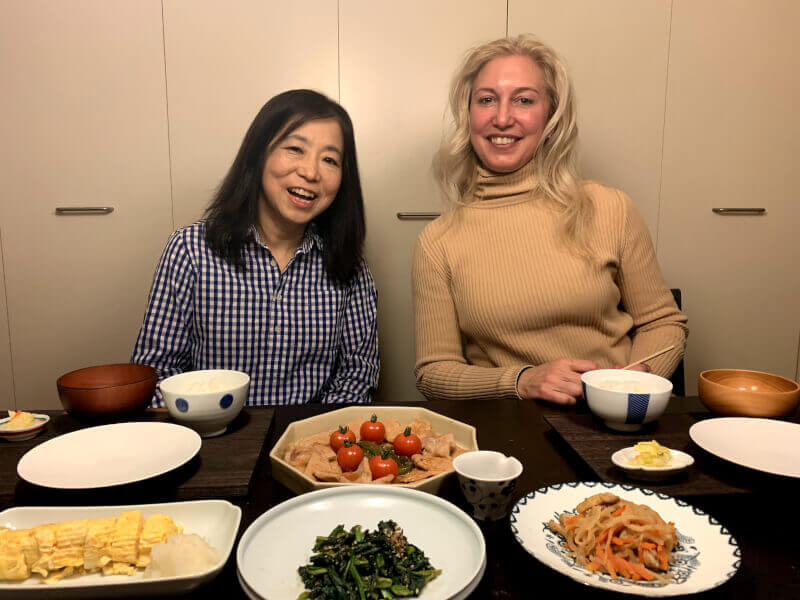
airKitchen’s popularity can be accredited to it satisfying overseas visitors’ desire to experience everyday Japanese life. They will cook authentic Japanese food in a common Japanese-style kitchen. In 2013, Washoku (“Japanese Food”) was registered as a UNESCO Intangible Cultural Heritage. The appeal of Japanese food is on the rise and is sure to become even more popular.
airKitchen Introductory Video
Some of the most popular foods taught on the website include gyoza, bento and sushi. A total of three hours are allotted for each experience which includes both the cooking and eating time. The price for each service varies but the average is ¥5,000 per person. The biggest ratio of nationalities come from Europe and Australia and range from couples to families.
If you’re travelling to Japan, why not book with airKitchen yourself and get a taste of everyday Japanese home life?
Information
▼airKitchen Official Website
https://airkitchen.jp/en/host.php▼Cooking Classes in Tokyo
https://airkitchen.jp/list/tokyo.php▼Cooking Classes in Kyoto
https://airkitchen.jp/list/kyoto.php -
Red Mount Fuji Curry Inspired by Japanese Ukiyo-e Painter Hokusai
15.January.2019 | FOOD
The Mount Fuji Lava Cafe, located in the Fujisan World Heritage Center in Yamanashi Prefecture, released a new Red Mount Fuji Curry on January 12 inspired by the woodblock print Fine Wind, Clear Morning from Hokusai’s Thirty-six Views of Mount Fuji series of landscape prints.
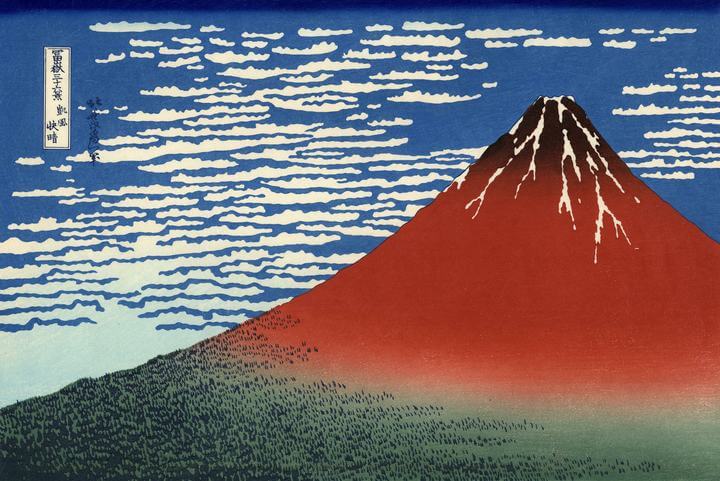
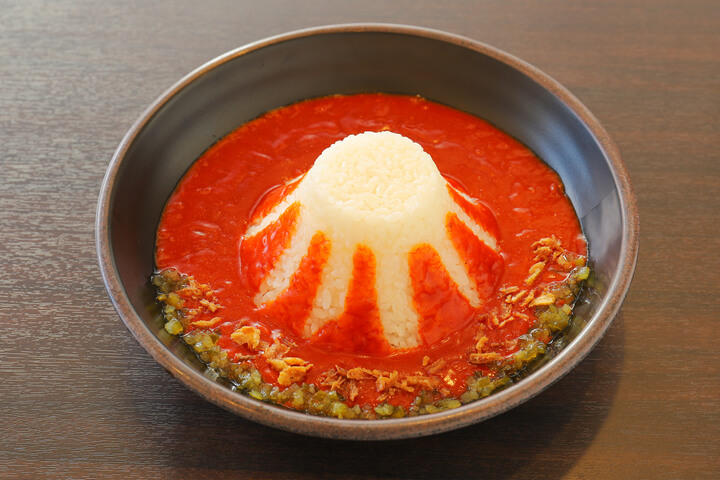
Red Mount Fuji Curry: ¥1,500 (Tax Included)
This red hot lava curry gets its vibrant colour from its picante spices and red chili oil. But it’s not simply a bowl of spiciness – it also has typical Japanese flavours like a dashi made from skipjack tuna and kombu. It’s also mixed with grape juice made from grapes grown in Fuefuki, Yananashi for deeper flavour.
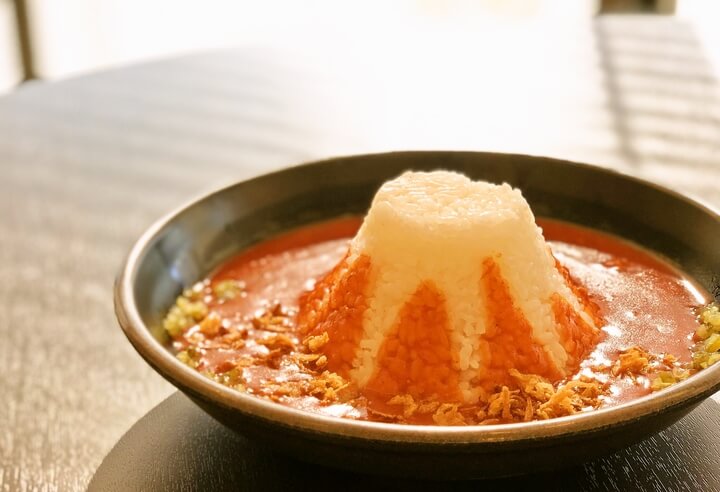
Upon ordering this curry you can pick from three different levels of spiciness. Those who order the highest level, dubbed “Mount Fuji’s Peak,” are offer to take part in an eating challenge. If you’re able to devour the hottest version of this curry within 22 minutes and 30 seconds the price of your bill will be wiped and you will receive a free ice cream.
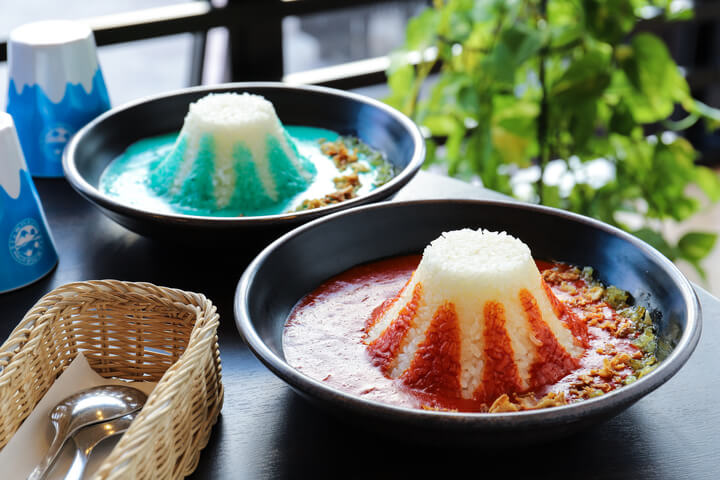
The Red Mount Fuji Curry serves as a follow up to the cafe’s original Blue Mount Fuji Curry which erupted in popularity on Japanese social media.
Information
Red Mount Fuji Curry
Price: ¥1,500 (Tax Included)
Description: https://www.fujisan-p.com/fujisanredcurry
Blue Mount Fuji Curry
Price: ¥1,000 (Tax Included)
Description: https://www.fujisan-p.com/fujisanbluecurry
Lava Cafe
Address: Fujisan World Heritage Center North Block 2F, 6663-1 Funatsu, Fujikawaguchiko-machi, Minamitsuru-gun, Yamanashi Prefecture
Opening Hours: 09:30-16:30 (Last Orders 16:00)
No Fixed Holidays.
TEL: 0555-72-0259
Information: https://tabelog.com/yamanashi/A1903/A190301/19009495/
-
Make Your Own Okonomiyaki at OKOSTA in Hiroshima Station
OKOSTA is a new studio opening at the north entrance/exit of Hiroshima Station on October 4, 2018 where you can have a go at making your own okonomiyaki. It is being opened to get more people liking okonomiyaki, both Japanese and foreigners, by letting them get hands on. They are now taking reservations both online and via telephone (082-277-7116).
The number of inbound foreign tourists to Japan has been on the increase in recent years, and the Japan Tourism Agency predict 40 million to arrive in Japan in 2020. The number of tourists visiting Hiroshima has also been increasing year by year, both Japanese and foreign.
Otafuku Sauce Co., Ltd. is an okonomiyaki and okonomiyaki sauce maker who have carried out activities to spread the word of okonomiyaki―the soul food of Hiroshimia―including its history, culture and nutritional value. They opened Wood Egg Okonomiyaki Kan in 2008 as a facility to do just this. As of July 2018, a total of 162,921 people from both Japan and overseas have visited the information center.
This is where OKOSTA comes in, a new experience that aims to have okonomiyaki leave a lasting impression on the many people visiting Hiroshima.
Okonomiyaki in Hiroshima piles on a huge range of different ingredients onto batter including fish meal, cabbage, tenkasu, spring onions, bean sprouts, pork, noodles, eggs and more. They’re also known in Japanese as kanaseyaki (‘fried layers’ i.e. layers of food).
OKOSTA gives you the chance to fry and prepare your own okonomiyaki using a hot iron plate and spatula just like at an okonomiyaki shop in Hiroshima.
Inside OKOSTA there will be four iron plates available to use. Up to 40 people can try out at once. They also cater for vegetarians by offering options without meat and fish.
Have a hand at making your own okonomiyaki at OKOSTA.
■Information
OKOSTA
Address: ekie DINING TERRACE, 1-2 Matsubaracho, Minami Ward, Hiroshima, Hiroshima Prefecture
Opening Hours: 10:00am-10:00pm (No Fixed Holidays)
TEL: 082-207-1277
Website: https://www.otafuku.co.jp/laboratory/event/okosta.html
Reservations: Telephone & OnlineCooking Times:
[Slot 1] 11:00am-12:30pm
[Slot 2] 1:00pm-2:30pm
[Slot 3] 7:00pm-8:30pm
Evening Set: 7:00pm-9:00pm -
Mount Fuji Pancakes Made in Lava Furnace Now Available in Yamanashi Prefecture
These ‘Mount Fuji Pancakes’ are cooked in lava furnaces at Mount Fuji. They’re being sold at The Noborisaka Hotel.
Mount Fuji Pancakes
Price: ¥980 (Tax Included)
Cooking the pancakes in a lava furnace causes the molecules to vibrate due to the far infrared effect. This means it cooks at a high temperature in a short period of time. Because of this, the necessary moisture ceases to evaporate, resulting in a soft, fluffy and deliciously cooked pancake. They’re made with mascarpone which leaves a refreshing taste in your mouth
Strawberry Chocolate Fondue Pancake
Price: ¥1,880 (Tax Included)
Mount Fuji European Style Curry (only 30 served per day)
Price: ¥1,280 (Tax Included)
There’s other dishes cooked in the furnaces too including pizza, steak and fried vegetables. It’s different from cooking in an ordinary furnace. The surface doesn’t burn but the heat, juices and flavour remain inside.
Try this ultimate Mount Fuji meal for yourself.
■Information
Mount Fuji Pancake
Opening Hours: 10:00am-9:00pm (Last Orders 8:00pm)
Address: The Norisaka Hotel 1F (6832 Funatsu, Fujikawaguchiko-machi, Minamitsuru-gun, Yamanashi Prefecture)
TEL: 0555-28-5310
Website: http://hotel-noborisaka.jp

